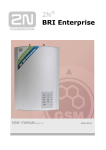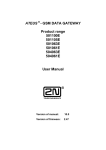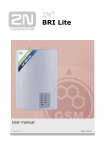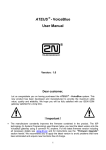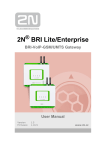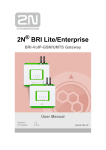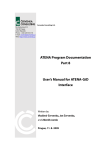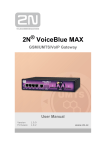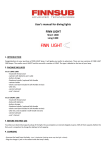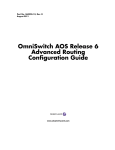Download ISDN BRI GSM Enterprise
Transcript
2N - ISDN BRI GSM Enterprise
Gateway
User Manual
Version: 1.3
Dear customer,
let us congratulate you on having purchased the 2N – ISDN BRI
GSM Gateway Enterprise system. This new product has been
developed and produced in order to provide the maximum utility
value, quality and reliability to the user. We hope you will be fully
satisfied with the 2N – ISDN BRI GSM Enterprise for a long time.
The manufacturer constantly improves the software
contained in the product (the so-called firmware).
The technology used therein helps you download the
latest firmware version to the ISDN BRI GSM
gateway using a common PC anytime. For the latest
firmware version see www.2n.cz. For necessary
instructions refer to Section 7.2 hereof. We
recommend you to apply the latest version to avoid
problems that have already been eliminated.
Grey marked text of this User Guide specifies
funkctions of VoiceBlue, which will be supported
in newer versions of firmware. You also find
the latest version of the User Manual at www.2n.cz
Check your delivery for completeness according
to the packing list and study this manual carefully
before installing this product. The manufacturer
shall not be responsible for damage caused by any
use of this product in contradiction with the User
Manual. The warranty terms and conditions do not
apply to damage incurred as a result of gross
handling and/or undue storing of the product
or violation of the technical parameters included
herein.
This manual is very much detailed and includes
subsections that are irrelevant for the basic
installation purposes as well as subsections referring
to other BRI GSM gateway models.
Packing List
Please check your 2N– ISDN BRI GSM Enterprise delivery
for compliance with the following packing list.
*
**
Item
Pieces
2N – ISDN BRI GSM gateway Enterprise – check the model
type according to the order number, see the type label on the
gateway back side
1
Mains adapter according to type
1
USB cable
1
ISDN 4-wire (RJ-45) cable
2
Antenna
1-2
Wall mounting holder
1
Dowels
2
Screws
2
This manual
1
Warranty certificate
1
Compliance certificate
1
2N product CD
1
none for rack version
according to the number of GSM modules
*
**
Contents
SECTION 1 – PRODUCT PRESENTATION..............................................1
1.1.
1.2.
1.3.
1.4.
Purpose.......................................................................................................2
How to Cut Telephone Costs .....................................................................2
Other Advantages and Applications ..........................................................3
RF Radiation Safety Precautions ...............................................................4
SECTION 2 – INSTALLATION ......................................................................5
2.1.
2.2.
2.3.
2.4.
2.5.
2.6.
2.7.
2.8.
2.9.
2.10.
2.11.
Get Started .................................................................................................6
Brief Installation Guide .............................................................................7
Proper Mounting ........................................................................................9
PC or LAN Connection*..........................................................................11
Antenna Connection ................................................................................12
Gateway Power Supply............................................................................13
SIM Card Installation/Removal ...............................................................14
NT and TE Connection ............................................................................14
Status Indicators.......................................................................................16
Lithium Battery Replacement..................................................................19
Fuse Replacement ....................................................................................20
SECTION 3 – ISDN BRI EXTENSION CONFIGURATION ............21
3.1.
3.2.
Point-to-Point Connection .......................................................................22
Point-to-Multipoint Connection...............................................................22
SECTION 4 – BRI GSM GATEWAY CONNECTION OPTIONS ....23
4.1.
4.2.
4.3.
Connection of ISDN TE to 2N – ISDN BRI GSM Enterprise ................24
2N – ISDN BRI GSM Enterprise Point-to-Point Connection .................24
2N – ISDN BRI GSM Enterprise as Pass-Through Router .....................27
SECTION 5 – TELEPHONY VIA ISDN BRI GSM GATEWAY .......28
5.1.
5.2.
5.3.
5.4.
5.5.
5.6.
Functions Supported by 2N – ISDN BRI GSM Enterprise Gateway ......29
Call Routing Rules...................................................................................29
LCR table.................................................................................................30
Routing of Outgoing GSM Calls .............................................................30
Routing of Incoming GSM Calls .............................................................33
DISA Message Recording .......................................................................36
ATEUS® - ISDN BRI GSM gateway Enterprise
SECTION 6 ETHERNET PORT CONFIGURATION .......................... 38
6.1.
6.2.
6.3.
Installation of Ethernet port drivers......................................................... 39
Virtual COM port installation ................................................................. 41
Virtual COM port additional configuration............................................. 44
SECTION 7 INTRODUCTION OF CONFIGURATION PROGRAM46
7.1.
7.2.
7.3.
7.4.
7.5.
ISDN GSM Program Installation ............................................................ 47
Running of ISDN GSM Control Program ............................................... 47
Configuration Program Basic Menu........................................................ 50
Button Bar ............................................................................................... 57
Topic List and Alphabetical Glossary ..................................................... 57
SECTION 8 CONFIGURATION .................................................................. 60
8.1.
8.2.
8.3.
8.4.
8.5.
8.6.
8.7.
8.8.
8.9.
8.10.
ISDN BRI GSM Gateway Communication Establishing........................ 61
Firmware Version Identification ............................................................. 61
Gateway License ..................................................................................... 62
Load / Save Parameters ........................................................................... 62
System Parameters................................................................................... 63
ISDN Parameters ..................................................................................... 64
GSM parameters - Outgoing ................................................................... 73
GSM parameters - Incoming ................................................................... 77
GSM parameters - Prefixes ..................................................................... 81
LCR table................................................................................................. 82
SECTION 9 – CONFIGURATION USING TERMINAL ..................... 86
9.1.
9.2.
9.3.
9.4.
9.5.
9.6.
9.7.
9.8.
9.9.
USB Communication Settings................................................................. 87
LAN Communication Settings ................................................................ 87
Terminal Communication........................................................................ 87
GSM Gateway Behaviour........................................................................ 87
List of Terminal AT Commands ............................................................. 88
Status Messages....................................................................................... 95
Records on Operation (LOG) .................................................................. 99
Records on Calls.................................................................................... 101
Statistics – Description .......................................................................... 102
SECTION 10 – TECHNICAL PARAMETERS ...................................... 105
Figures
Fig. 1 – Bottom View...............................................................................................6
Fig. 2 – Top View ....................................................................................................6
Fig. 3 – Gateway Holder Wall-Mounting ................................................................9
Fig. 4 – Gateway Hanging .......................................................................................9
Fig. 5 - Direct PC Connection*..............................................................................11
Fig. 6 – LAN Connection.......................................................................................12
Fig. 7 - RJ-45 Wiring for LAN Connection...........................................................12
Fig. 8 – Antenna Connection .................................................................................12
Fig. 9 – Supply Adapter Connection......................................................................13
Fig. 10 – SIM Card Inserting Procedure ................................................................14
Fig. 11 - TE and NT Connector Pins .....................................................................15
Fig. 12 - ISDN GSM Gateway Connected as Network Terminal (NT).................15
Fig. 13 - ISDN GSM Gateway Connected as ISDN Terminal (TE)......................15
Fig. 14 - Basic ISDN GSM Gateway Wiring Diagram..........................................16
Fig. 15 - Signalling LEDs ......................................................................................16
Fig. 16 – Motherboard Diagram ............................................................................19
Fig. 17 - Point-to-Point Connection.......................................................................22
Fig. 18 - Point-to-Multipoint Connection ..............................................................22
Fig. 19 - ISDN Telephone-Gateway Connection with Power Supply Simulation.24
Fig. 21 - ISDN BRI GSM Point-to-Point Connection as ISDN NT ......................25
Fig. 22 - ISDN BRI GSM Point-to-Point Connection as ISDN NT with Public
ISDN Synchronisation ...................................................................................26
Fig. 23 - Multiple ISDN BRI GSM Gateway Connection.....................................26
Fig. 25 - BRI ISDN GSM Gateway Connection as Pass-Through Router
with PBX........................................................................................................27
Fig. 27 - Routing of Outgoing Calls to GSM Network..........................................32
Fig. 28 - Incoming Call Processing Procedure ......................................................35
Fig. 29 – Ethernet port installation Welcome window ..........................................39
Fig. 30 – Selection of optional part of installation.................................................40
Fig. 31 – End of installation...................................................................................40
Fig. 32 – Open program folder checkbox ..............................................................41
Fig. 33 – Start of VSM Manager............................................................................41
Fig. 34 – OS Windows appeal ..............................................................................42
Fig. 35 – Virtual COM port configuration window ...............................................43
Fig. 36 – Added port in VSP Manager...................................................................44
Fig. 37 - DS Manager window...............................................................................44
ATEUS® - ISDN BRI GSM gateway Enterprise
Fig. 38 – Ethernet port settings..............................................................................45
Fig. 39 – Configuration of RS232 converter .........................................................45
Fig. 40 – Gateway Selection Window ...................................................................48
Fig. 41 – Gateway Editing Window ......................................................................49
Fig. 42 - GSM Configuration Program Basic Menu..............................................50
Fig. 43 – Function Item of Main Menu .................................................................52
Fig. 44 – Modules diagnostics window .................................................................52
Fig. 45 – Tracing Window.....................................................................................53
Fig. 46 – Firmware Finding and Uploading Window............................................54
Fig. 47 – Key Finding and Uploading Window ....................................................55
Fig. 48 – Communication Setting Window ...........................................................56
TFig. 49 – GSM Configuration Program Button Bar ............................................57
Fig. 50 – Topic List (left) and Alphabetical Glossary (right)................................58
Fig. 51 – System Parameter Editing Window .......................................................63
Fig. 52 – ISDN Parameter Editing Window..........................................................64
Fig. 53 – Basic GSM Parameter Editing Window.................................................69
Fig. 54 - Editing Window of GSM outgoing parameters ......................................73
Fig. 55 - Incoming GSM Group Editing Window.................................................77
Fig. 56 - Network List Editing Window................................................................81
Fig. 57 – LCR table ...............................................................................................82
Fig. 58 – LCR table Data Entering ........................................................................83
Fig. 59 – Login message........................................................................................88
ATEUS® - ISDN BRI GSM Gateway Enterprise
1
SECTION 1 –
Product Presentation
Here is a survey of what you will find in this section:
• Purpose
• How to Cut Telephone Costs
• Other Advantages and Applications
• RF Radiation Safety Precautions
1
2N - ISDN BRI GSM Enterprise Gateway
1.1. Purpose
•
The 2N - ISDN BRI GSM Enterprise gateway helps
interconnect the ISDN and GSM networks. It can also be
applied in direct ISDN PBX - GSM connections,
in combination with an ISDN telephone set, analog telephone
set or a coin-operated telephone connected through a terminal
adapter, etc.
• The voice mode, i.e. an outgoing or incoming call, is the basic
function of the system. The gateway is equipped with all
functions necessary for such use and provides a very high
comfort in this mode.
• In addition to voice transmission, 2N - ISDN BRI GSM
Enterprise gateways can send and receive short text
messages. This function along with other additional functions
enhances the utility value of the product.
• No extra equipment (an external GSM telephone, etc.) is
needed for normal operation. All programmable parameters are
default-preset in such a manner that you can commence your
telephone traffic the moment you connect the USB and supply
cables, antenna and SIM card and set the ISDN and GSM
parameters.
1.2. How to Cut Telephone Costs
• Once your 2N – ISDN BRI GSM Enterprise gateway has
been connected to your ISDN PBX, all calls going out to
a mobile network are made directly. This saves your PSTN mobile network call costs. All mobile telephone calls of your
personnel in the field are cheaper too.
• You are advised to use the most advantageous rate of your
GSM provider for your GSM gateway because all gateway
user call accounts are added up for billing purposes.
• You can bar selected numbers or groups of numbers in your
gateway. You shall pay nothing for the calls you have
barred.
2
2N - ISDN BRI GSM Enterprise Gateway
• 2N - ISDN BRI GSM Enterprise keeps detailed records on all
calls. This helps you find out easily why your bill is higher
than it should be.
• The Least Cost Router is flexible enough to help you set rules
for GSM calling at the lowest possible operation costs.
• The intelligent CallBack function enables your personnel to call
at the cost of your GSM gateway SIM cards.
1.3. Other Advantages and Applications
• BRI GSM gateways integrate the best of their respective
communication technologies.
• The Intelligent Routing of Incoming Calls function
accelerates connecting of incoming calls and makes calling
more comfortable.
• The DISA function with an easily recordable welcome message
is available.
• You can use the conditioned or unconditioned call forwarding
function.
• Unlike mobile telephones, this system does not expose you
to the RF electromagnetic field while making calls.
• Password for configuration of the gateway on all ports
• CLIP and CLIR for incoming calls from GSM network
• ENBLOC / OVERLAP mode of sending called number
to ISDN network
• Sending of SMS messages in case of missed call on GSM
network side
• Generation of AoC or resending Aoc from GSM network
• Table of allowed / restricted calling party numbers from GSM
• GPRS over USB port
3
2N - ISDN BRI GSM Enterprise Gateway
1.4. RF Radiation Safety Precautions
It is prohibited to use any transmitters, including
GSM gateways, in areas where explosives are used,
such as quarries.
It is forbidden to use mobile phones and thus GSM
gateways too at refuelling points.
A GSM gateway may affect sensitive life-saving
devices in medical centres. So it is prohibited to use
mobile phones and GSM gateways here.
In general, any restriction regarding mobile phones
based on RF energy radiation applies to GSM
gateways.
Where necessary, a GSM gateway may be installed
at a safe distance (in the neighbouring building, e.g.)
and a BRI ISDN connection cable may be carried
from the GSM gateway to the original building.
Although GSM gateways are not intended
for aircraft or cars, all relevant restrictions
and regulations regarding mobile phones apply
to them here.
4
2N - ISDN BRI GSM Enterprise Gateway
2
SECTION 2 –
Installation
Here is a survey of what you will find in this section:
• Get Started
• Brief Installation Guide
• Proper Mounting
• PC or LAN Connection* 1
• Antenna Connection
• Gateway Power Supply
• SIM Card Installation/Removal
• NT and TE Connection
1
According to the order number
5
2N - ISDN BRI GSM Enterprise Gateway
• Status Indicators
• Lithium Battery Replacement
• Fuse Replacement
2.1. Get Started
Before you start installing your BRI Enterprise gateway, get
familiar with its physical structure, arrangement of connectors
and status indicators, see Fig. 1, Fig. 2, and Fig. 15.
Fig. 1 – Bottom View
Fig. 2 – Top View
6
2N - ISDN BRI GSM Enterprise Gateway
2.2. Brief Installation Guide
• Proper mounting – 2N – ISDN BRI GSM Enterprise
is designed for suspension on a vertical surface. Fit the holder
included in the delivery on a wall and hang the gateway on it.
For details on the prescribed working position and other
recommendations refer to Subs. 2.3.
• Cable connection – connect the gateway using ISDN cables
to your ISDN PBX (or any other ISDN terminals). Connect
the cables from your ISDN extension to the gateway too. For
more details on proper wiring refer to Subs. 2.4.
• Antenna connection – connect an internal antenna or
an external antenna cable into the SMA antenna connector.
Place the external antenna on a place with a good GSM signal
(refer to Subs. 2.5).
• Gateway power supply – the delivery includes a mains
adapter. Plug in the adapter connector into the gateway and the
power adapter into a wall socket. The gateway turns
on immediately (see Subs.2.6).
• SIM card insertion – SIM cards are inserted in holders
on the gateway top. The SIM card holder is of the push/pull
type, which means that all you have to do is insert a SIM card
and press the holder gently until it snaps into position (see
Subs.2.7). Secure the SIM card with a latch to avoid incidental
removal. !CAUTION! If you use PIN-asking SIM cards, first
set an identical PIN code for all SIM cards used in the GSM
gateway, save it into the GSM gateway configuration and only
then insert the SIM cards in the GSM gateway.
• PC connection – the gateway parameters are normally set
using the configuration software available on the CD included
in the delivery. To interconnect your PC with the GSM ISDN
gateway use the USB or patch cable included in the delivery * .
• Configuration program installation - run the installation file
from the installation CD on a PC connected to the gateway
and install the ISDN GSM configuration software
(refer to Subs. 7.1).
*
T according to the order number
7
2N - ISDN BRI GSM Enterprise Gateway
• Configuration program - run the ISDN GSM program
installed and select a virtual COM port for your PC - gateway
connection. Establish communication between your PC and
the gateway (refer to Subs. 8.1).
• 2N - ISDN BRI GSM Enterprise configuration - now use the
configuration software to set all necessary gateway parameters
- ISDN parameters, basic GSM parameters and tariff
metering/pricing parameters, routing, restrictions, rates, system
parameters, and input and switch properties. Having set the
required parameters, upload the configuration data to the
gateway via a serial link. For more details on the configuration
software see Section 8.
8
2N - ISDN BRI GSM Enterprise Gateway
2.3. Proper Mounting
• The 2N - ISDN BRI GSM Enterprise gateway is designed
for mounting on a vertical surface. For this purpose
a wall- mounting holder is available. Just fit the holder with
dowels and screws (Fig. 3) to the wall and hang the gateway
as shown in Fig. 4.
Fig. 3 – Gateway Holder Wall-Mounting
Fig. 4 – Gateway Hanging
• It is possible to operate the BRI GSM gateway in another
working position (e.g. on a desk) for a short time only,
for example in servicing centres for quick testing purposes.
9
2N - ISDN BRI GSM Enterprise Gateway
The allowed working temperature and relative humidity ranges
are included in Section 10.
• Exceeding the recommended operating temperature values
need not affect the gateway function immediately but may
result in more rapid ageing and lower reliability.
• The gateway is intended for indoor use. It may not be exposed
to rain, flowing water, condensed moisture, fog, or mist.
• The gateway may not be exposed to aggressive gas, acid
vapours, solvents, etc. or aggressive liquids, during cover
cleaning, for example.
• The GSM gateway is not designed for high-vibration
environments, e.g. means of transport, machine rooms, etc.
• Free space has to be left under and over the gateway for cables
and agitated air to remove operational heat.
• Install the gateway on a place with a good GSM signal.
• A misplacement of the GSM gateway or its antenna near
television, broadcasting or similar RF-sensitive devices may
evoke an adverse effect upon their function.
• Being a source of RF energy emission, the gateway antenna
should not be located close to human bodies. The hazard
is higher than with mobile telephones because the gateway
is usually used by many people and thus employed more often.
10
2N - ISDN BRI GSM Enterprise Gateway
2.4. PC or LAN Connection*
The 2N - ISDN BRI GSM Enterprise gateway can be connected
to a PC using a USB cable terminated with a USB B connector.
A direct connection of 2N - ISDN BRI GSM Enterprise and a PC
is necessary for the initial gateway configuration when
the gateway IP address is unknown and the gateway cannot
be configured using the LAN * . The GSM gateway is set to operate
as a modem in the data mode, communicating through a virtual
COM port.
The gateway USB port default parameters are 921,600 bps, 8 data
bits, no parity, 1 stop bit, no flow control. Set the same parameters
for the communication program on the PC side.
Fig. 5 - Direct PC Connection*
2N - ISDN BRI GSM Enterprise is connected to the
10/100BASE-T (Twisted Pair Ethernet) LAN using a standard
straight through cable terminated with a RJ-45 connector (Fig. 7).
This connector is not included in all 2N - ISDN BRI GSM
Enterprise types.
*
according to the particular GSM ISDN gateway type
11
2N - ISDN BRI GSM Enterprise Gateway
Fig. 6 – LAN Connection
Fig. 7 - RJ-45 Wiring for LAN Connection
2.5. Antenna Connection
The BRI GSM gateway has one SMA antenna connector for each
GSM module, see Fig. 8. An external antenna cable is connected
to these connectors. The external antenna should be installed
vertically on a place with a good GSM signal. For the technical
parameters of the antennas refer to Section 10.
Fig. 8 – Antenna Connection
12
2N - ISDN BRI GSM Enterprise Gateway
Tighten the antenna connector gently with your hand, never use
a wrench!
2.6. Gateway Power Supply
• Be sure to use only the mains supply adapter that is included
in the gateway delivery.
• Before plugging in the gateway, make sure that the mains
voltage value meets the data given on the mains adapter label.
• Make sure that the antenna has been connected. If you connect
the gateway to the power supply without an antenna, the GSM
module transmitter might get damaged.
• Now plug the supply adapter into a mains socket and connect
the adapter connector to the gateway, see Fig. 9. The status
indicators indicate the proper operation. For their meanings
refer to Subs. 2.9.
Fig. 9 – Supply Adapter Connection
13
2N - ISDN BRI GSM Enterprise Gateway
2.7. SIM Card Installation/Removal
Insert the SIM card into the SIM card slots with your hand
as shown in Fig. 10. Please make sure that the SIM card contact
plates are on the side closer to the GSM gateway antenna
connectors. Having inserted the SIM card, push the card gently
until you hear a click signalling that the card has been snapped
by the push/pull holders. Secure the SIM card by shifting the latch
to the right in order to avoid incidental removal of the SIM card.
To remove the SIM card take the opposite steps. You can replace
a SIM card even with the gateway on.
Fig. 10 – SIM Card Inserting Procedure
In case of SIM card replace is necessary to make restart of GSM
module or whole gateway.
2.8. NT and TE Connection
ISDN terminals are connected to the NT and TE connectors
depending on the configuration of your telecommunication
equipment. They are connected using a 4-wire passive bus through
RJ-45 connectors. For NT or TE connections see Fig. 12 and
Fig. 13. The RJ-45 pins for TE and NT are shown in Fig. 11.
14
2N - ISDN BRI GSM Enterprise Gateway
Fig. 11 - TE and NT Connector Pins
Fig. 12 - ISDN GSM Gateway Connected as Network Terminal (NT)
Fig. 13 - ISDN GSM Gateway Connected as ISDN Terminal (TE)
15
2N - ISDN BRI GSM Enterprise Gateway
Fig. 14 - Basic ISDN GSM Gateway Wiring Diagram
Choose the specific wiring as shown in Section 4.
2.9. Status Indicators
There is a panel with five LEDs on the gateway upper cover
for a quick GSM gateway status detection (see Fig. 15).
The Power LED signals that the gateway as a whole is
in operation. The BRI 1 and BRI 2 LEDs indicate the status of both
the B channels of the basic ISDN extension, and the GSM 1
and GSM 2 LEDs indicate the status of the respective GSM
modules.
Fig. 15 - Signalling LEDs
Basic diagnostic tests and gateway initialisation are performed
automatically whenever the gateway is connected to supply
voltage. Each test step is signalled by a specific colour
combination of the LEDs. If a test step fails, the indicator
combination related to the failed test remains lighted.
This provides a convenient troubleshooting tool to the technical
support personnel.
16
2N - ISDN BRI GSM Enterprise Gateway
Power Indicator
The Power LED signals whether the BRI GSM gateway is
supplied or not.
Power Indicator (green)
Power
LED colour/status
No light
The system is not working. / Blown fuse.
Continuous light
The system is working.
Tab. 1 – Survey of Power Indicator Statuses
BRI Indicators
The BRI 1 and BRI 2 LEDs signal the statuses of your ISDN
extension B channels, each being assigned to two lines
of the opposite direction (TE1/NT1; TE2/NT2). BRI 1 indicates
the status of the B channels between the GSM gateway and ISDN
terminals, while BRI 2 relates to the B channels between the GSM
gateway and network termination, or your PBX, see Subs. 4.3.
BRI 1 / BRI 2 (green)
BRI 1 / BRI 2
LED colour / status
Channels are not occupied and physical
no light
and data link layers are activated
TEI binded, link layer not activated
Orange / BRI 1 or BRI 2 are shining
1 B-channel towards TE is occupied
Green / BRI 1 is shining
2 B-channels towards TE are occupied
Green / BRI 1 is shining
1 B-channel towards NT is occupied
Green / BRI 2 is shining
2 B-channels towards NT are occupied
Green / BRI 2 is shining
TE not connected
Red / BRI 1 is shining
Physical layer activated
Red / BRI 1 or BRI 2 are blinking
NT (PBX) not connected
Red / BRI 2 is shining
Tab. 2 – Survey of BRI 1 / BRI 2 Indicator Statuses
17
2N - ISDN BRI GSM Enterprise Gateway
GSM Indicators
The GSM 1 and GSM 2 indicators signal statuses of the respective
GSM modules. Whenever the 2N - ISDN BRI GSM Enterprise
gateway is started, detection of the GSM modules and SIM cards
is carried out. This process is signalled by a red LED, which goes
on a few seconds after voltage is supplied. The GSM module
detection takes a few seconds. In case a GSM module or SIM card
is absent, the red LED keeps shining. If a GSM module is not
supplied, the respective GSM LED is blinking red. After a correct
GSM module initialisation, the SIM card starts logging
into the provider's network, which is indicated by a quickly
blinking green colour. If the log-in has been successful, the LED
goes out. If not, it shines red.
In normal operation, a slowly blinking green LED indicates
establishing of an incoming or outgoing call and a permanently
green LED means a successfully established connection within
the respective GSM module.
A survey of GSM module status signalling is included in Tab. 3
GSM indicators
GSM 1 or GSM 2
LED colour / status
The module is ready and logged-in
No light
Call establishing
Green / blinking slowly 1:1
Currently made call
Green / shining
SIM card initialisation
Green / blinking quickly 1:1
SIM card initialisation in progress
Shining red
GSM module / SIM card absent
Red / shining
GSM module not supplied
Red / blinking quickly
Tab. 3 - Survey of GSM Module Status Signalling
18
2N - ISDN BRI GSM Enterprise Gateway
2.10. Lithium Battery Replacement
WARNING! An incorrect battery replacement
may result in explosion. For replacement, batteries
of the same or equivalent type as recommended
by the manufacturer may be used only. The battery
type is CR2032.
WARNING! Never use metal tools for battery
replacement to avoid short-circuit. Battery shortcircuiting may result in battery destruction
or explosion.
Keep the proper battery polarity.
Dispose of used batteries in accordance
with applicable waste regulations, for example in
waste recycling centres.
Fig. 16 – Motherboard Diagram
The lithium battery only supplies the real time internal clock in the
ISDN BRI GSM Enterprise gateway in the event of power failure.
19
2N - ISDN BRI GSM Enterprise Gateway
It is unnecessary for the gateway function. Its average service life
is approximately 3 years. You are recommended to replace it after
three years for preventive purposes or, at least, check the voltage
with a voltmeter (the value should not drop below 2.9 V).
A completely low battery results in the ISDN BRI GSM Enterprise
gateway losing the time and date information - false data appear
also in the service log buffer listing.
Replacing the lithium battery, first disconnect your ISDN BRI
GSM Enterprise gateway from the mains and open the cover.
Remove the old battery from the holder using a suitable tool
and install a new one.
2.11. Fuse Replacement
WARNING! Use only a fuse of the same type.
Disconnect the adapter power while replacing the
fuse.
Fuse can be replaced only by service which
is personnel qualified to check such parameters
as power consumption, DC voltage etc.
If fuse fails again, unit must be returned
to manufacturer for repair
To exchange the fuse disconnect power adapter cable first.
The location of the fuse on the main board is on the Fig. 16. Open
the cover, remove the faulty fuse and check it. Replace the fuse
by a fuse of the same type only. Close the cover and reconnect
the power adapter cable.
20
2N - ISDN BRI GSM Enterprise Gateway
3
SECTION 3 –
ISDN BRI Extension Configuration
To configure your 2N - ISDN BRI GSM Enterprise gateway
properly, you have to know the type of connection of your ISDN
terminals. This section helps you install your GSM gateway
between already interconnected ISDN terminals.
For information on the ISDN type refer to your ISDN provider's
registration form or check with your telephone network
administrator.
This section includes:
• Point-to-Point Connection
• Point-to-Multipoint Connection
21
2N - ISDN BRI GSM Enterprise Gateway
3.1. Point-to-Point Connection
The Point-to-Point (EuroISDN with DDI) configuration
interconnects directly one ISDN terminal (TE) with a network
terminal (NT) (see Fig. 17). This type is applied mainly where
PBXs are connected to the ISDN.
Fig. 17 - Point-to-Point Connection
3.2. Point-to-Multipoint Connection
Point-to-Multipoint (EuroISDN with MSN) is another type
of ISDN terminal interconnection. Here the network terminal (NT)
is interconnected with up to eight ISDN terminals through a 4-wire
passive bus as shown in Fig. 18.
Fig. 18 - Point-to-Multipoint Connection
22
2N - ISDN BRI GSM Enterprise Gateway
4
SECTION 4 –
BRI GSM Gateway Connection Options
This section deals with the connection options of the 2N - ISDN
BRI GSM Enterprise gateway to the ISDN Basic Rate extension.
This section includes:
• Connection of ISDN TE to 2N – ISDN BRI GSM Enterprise
• 2N – ISDN BRI GSM Enterprise Point-to-Point Connection
• Chyba! Nenalezen zdroj odkazů.
• 2N – ISDN BRI GSM Enterprise as Pass-Through Router
23
2N - ISDN BRI GSM Enterprise Gateway
4.1. Connection of ISDN TE to 2N – ISDN BRI GSM Enterprise
The connection in Fig. 19 provides communication via a GSM
gateway without PSTN connection. The ISDN telephone set
is connected to the NT port of the GSM gateway, while a mains
adapter simulating power supply from the public network
is connected to the TE port. The adapter is available under the part
No. 5020002.
Fig. 19 - ISDN Telephone-Gateway Connection with Power Supply Simulation
4.2. 2N – ISDN BRI GSM Enterprise Point-to-Point
Connection
This type of connection is especially suitable for direct calls
from an ISDN branch network to a GSM network.
24
2N - ISDN BRI GSM Enterprise Gateway
Fig. 20 - ISDN BRI GSM Point-to-Point Connection as ISDN NT
Fig. 21 shows the possible connection of the GSM gateway
as an NT and the gateway synchronisation is derived from the BRI
extension.
25
2N - ISDN BRI GSM Enterprise Gateway
Fig. 21 - ISDN BRI GSM Point-to-Point Connection as ISDN NT with Public ISDN
Synchronisation
Fig. 22 - Multiple ISDN BRI GSM Gateway Connection
26
2N - ISDN BRI GSM Enterprise Gateway
4.3. 2N – ISDN BRI GSM Enterprise as Pass-Through
Router
Fig. 23 shows how to save one BRI port to the PBX where the
GSM gateway is set to operate as a pass-through gateway with
respect to incoming calls while outgoing calls are routed according
to the ISDN BRI GSM gateway LCR table.
Chyba! Nenalezen zdroj odkazů. shows the ISDN BRI GSM
gateway as a pass-through router for a Point-to-Multipoint
connection. Calls are routed automatically to the GSM network or
ISDN according to the GSM gateway LCR table. The GSM
gateway
DTMF
is
not
needed
in this arrangement.
Fig. 23 - BRI ISDN GSM Gateway Connection as Pass-Through Router with PBX
27
2N - ISDN BRI GSM Enterprise Gateway
5
SECTION 5 –
Telephony via ISDN BRI GSM Gateway
This section contains information on routing calls through
the ISDN BRI GSM gateway. Gateway configurations are
described that help you make the most of the gateway potential
and minimise your telephone costs.
This section includes:
• Functions Supported by 2N – ISDN BRI GSM Enterprise
• Call Routing Rules
• LCR table
• Routing of Outgoing GSM Calls
• Routing of Incoming GSM Calls
• DISA Message Recording
28
2N - ISDN BRI GSM Enterprise Gateway
5.1. Functions Supported by 2N – ISDN BRI GSM
Enterprise Gateway
• Call routing according to time and called destination through
the destination's operator;
• Intelligent incoming CLIP routing;
• Auto CLIP routing;
• Outgoing call routing by time LCR (Least Cost Routing);
• DISA (tone dial-in);
• DISA to GSM (tone dial-in from ISDN ports to GSM
networks);
• CallBack to GSM;
• SMS sending/receiving;
• Missed call SMS;
• LAN or Internet based configuration (according to the GSM
gateway type).
• Password for configuration of the gateway on all ports
• CLIP and CLIR for incoming calls from GSM network
• ENBLOC / OVERLAP mode of sending called number
to ISDN network
• Generation of AoC or resending AoC from GSM network
• Table of allowed / restricted calling party numbers from GSM
• GPRS over USB port
5.2. Call Routing Rules
The GSM gateway ports are logically divided into internal and
external. While GSM ports are external only, ISDN ports can be
both internal and external. You can define whether your internal
port calls should be routed to external ports, or to the operator,
or according to the active DISA function (tone dial-in).
Furthermore, you can route calls according to the CLIP, MSN
(Multiple Subscriber Number) (for ISDN extensions), or direct
GSM gateway dial-in (ISDN extension with DDI).
29
2N - ISDN BRI GSM Enterprise Gateway
If an outgoing call is routed via a port that is busy, the remaining
available ports are searched for (depending on the configuration)
and if no allowed outgoing port is free, the outgoing call
is rejected.
The routing algorithm routes outgoing calls according to the
outgoing call type, current time rate, day in a week, and GSM
provider's free minutes if any.
5.3. LCR table
The LCR (Least Cost Routing) chart is the key telephone cost
cutting factor. It helps you set the call routing rules according to
the CLIP, daytime and day in a week. By entering public holidays
into the LCR table you achieve even more remarkable cuts.
To make call routing to external ports based on prefixes and the
LCR table work properly, enter the GSM provider including its
respective code and prefix and the count of prefix-following digits
into the GSM destination table.
The ISDN GSM gateway also allows you to route outgoing GSM
calls on the basis of the SIM card position. In this case, outgoing
calls are not routed according to the GSM provider's number but
through the defined GSM module.
In addition, the ISDN ports can work in the pass-through mode.
This means that all calls are routed to the respective
complementary port without any check. Namely, from TE 1 to NT
1 and vice versa.
5.4. Routing of Outgoing GSM Calls
If the GSM gateway is connected to your PBX internal line, enable
the DISA function to the GSM network to make your GSM
gateway answer every call routed to it by the PBX and wait for
further dialling to GSM networks.
If necessary, this function can be restricted by defining a password
or selecting the CLIP.
Routing of outgoing calls via the ISDN BRI GSM gateway
proceeds as follows:
• The calling subscriber dials a number.
30
2N - ISDN BRI GSM Enterprise Gateway
• If the number is evaluated as the "access to the GSM gateway“,
the table of barred numbers is searched and if a match is found,
the call request is rejected.
• The ISDN GSM gateway waits for further digits to be dialled.
This timeout results in a certain delay between the subscriber's
dialling and the subsequent dialling by the GSM gateway.
Therefore, select the Default count of digits for called
destinations while configuring your ISDN GSM gateway. Then
the ISDN GSM gateway initiates the outgoing call processing
algorithm on receiving the last digit.
• The dialling prefix is first checked with the prefixes included
on the first line of the LCR table. If no match is found, the
following line is used for comparison.
• If the prefix matches a LCR prefix, the call time is checked for
match with the routing rule on the line. Again, if no match
is found, the following LCR table line is searched.
• In case the prefix and call time comply with the routing rules,
the call is routed according to the first routing rule included
in Groups and GSM outgoing groups to the module
corresponding to the particular GSM outgoing group.
• If the selected GSM module is busy or has an insufficient
credit, the preceding step is repeated for the following line
of the Groups section. If there is no record, the next LCR table
line is searched.
• In case the selected GSM module is free and has a sufficiently
high credit, the GSM gateway starts dialling a GSM number.
• If the calling subscriber number has an unknown prefix, or all
routes are busy, the GSM gateway rejects the call request.
• An outgoing call is not billed until the called party answers the
call.
• The GSM network signals the off-hook and the GSM gateway
transfers this information to the PBX.
• The gateway is able to generate tariff rate pulses - AOC during an outgoing call, which, if the GSM gateway is
connected to the PBX, allows for call cost logging per user.
31
2N - ISDN BRI GSM Enterprise Gateway
Fig. 24 - Routing of Outgoing Calls to GSM Network
32
2N - ISDN BRI GSM Enterprise Gateway
5.5. Routing of Incoming GSM Calls
Incoming calls from the GSM network are subject to the algorithm
described in Fig. 25 and the following steps:
Incoming calls are processed according to the Mode parameter
in the GSM incoming groups chart. The following options are
available:
• Ignore incoming calls – incoming calls are not routed
to extensions. The call request is either rejected or ignored
(the calling party hears the ringing tone) on the GSM network
side.
• Report to PC – the information on an incoming call is sent to a
PC equipped with the management software. The calling
subscriber gets a voice message or check ringing tone.
The management software then completes the call routing
procedure.
• CallBack – this function helps establish connection on the
account of the SIM card inserted in the GSM gateway.
The incoming call is either ignored or rejected. After the
calling subscriber hangs up, the GSM gateway establishes
connection to the defined extension. When the extension
answers, the GSM gateway replays the CallBack message
to the extension while establishing a connection to the
previously calling subscriber in the GSM network. After the
CallBack message, the GSM gateway interconnects the call.
If the CallBack function with ignoring of incoming calls is
enabled and the calling party fails to hang up within a defined
timeout (default = 10 s), the CallBack function is disabled
for this call and the subscriber can go on dialling the extension
number.
• If neither of the above-mentioned options is selected, the
AutoCLIP routing table is checked. If the calling number
is found, the call is routed to the extension whose number
is assigned to the calling number in the table.
33
2N - ISDN BRI GSM Enterprise Gateway
• In case the calling number is not included in the AutoCLIP
routing chart, or the AutoCLIP routing function is disabled,
the gateway receives the incoming call and either replays
a voice message or transmits the dial tone to the calling party.
Then the gateway awaits the count of digits necessary for call
establishing. To define the minimum and maximum counts
of DTMF digits use the GSM incoming groups menu.
• If the gateway does not receive the minimum required count
of digits and no other digit comes from the GSM network
within the timeout defined in DTMF dialling delay, the call
is rerouted to the operator as the case is when the extension
number dialled by the calling party is unknown.
• If the call rerouting to the operator is inactive, the incoming
call is rejected.
34
2N - ISDN BRI GSM Enterprise Gateway
Fig. 25 - Incoming Call Processing Procedure
35
2N - ISDN BRI GSM Enterprise Gateway
5.6. DISA Message Recording
If the DISA function is enabled and a welcome message recorded,
this voice message is replayed to every incoming call whose
number is not included in the AutoCLIP routing table. After the
message is replayed, the gateway waits for the first DTMF digit
for a timeout defined in the GSM incoming groups – Tout for
entering DTMF digits [s]: table. Having received the count of
digits defined in GSM incoming groups – Min. digits in DTMF, the
gateway activates the PBX or telephone connection with the
number received by the DTMF via the port specified in the ISDN
parameters table. For more details on the gateway configuration
refer to Section 8.
To establish connection with a lower count of digits than defined
in GSM incoming groups – Max. digits in DTMF, terminate the
dialling with the '#' character. When the DISA does not receive the
pre-programmed count of digits or the '#' character, the connection
is not established. Therefore, enable the operator service while
activating the DISA function (in the router mode only, no '#' is
needed in the PBX mode).
There are three ways to program the DISA voice message into the
gateway:
• Record DISA using configuration program
• Record the voice message from GSM telephone
• Record DISA into your PC and save the disa.wav file into your
gateway using the XMODEM protocol.
36
2N - ISDN BRI GSM Enterprise Gateway
DISA Message Recording using terminal and GSM phone
Recording of DISA message
Open terminal window (see Subs 9).
• Establish connection with your GSM phone using AT
command: at!sg0=phone_number_of_your_GSM_phone
• Accept incoming call from your GSM gateway by GSM phone.
(CLIP of SIM card plugged in SIM card holder 1)
• Enter AT command at!m=record in terminal window which
results in recording of DISA message (60 s max)
• To stop recording of DISA message press ENTER
• Finish the phone call by hanging up or entering of AT
command at!d
Erasing of DISA Message
To get an information on recorded DISA Message enter AT
command at!m=status. To erase DISA message enter AT
command at!m=erase in terminal window.
Recording of DISA Message using terminal and PC
Recording the voice message into your PC keep the maximum
length of 65 s, compression according to the ISDN A-law codec,
mono, sampling frequency of 8 kHz. The voice message recording
program is part of your BRI GSM gateway software delivery.
Summary of parameters the file must meet is in table Tab. 4
below. Name the file Disa.wav and upload it to BRI Enteprise
using a terminal and the XMODEM transmission protocol.
DISA Voice File Parameters
Sound format
Sampling frequency
Count of channels
Codec
Wav
8 kHz
1 mono
ISDN A-law
Tab. 4 DISA Message File Parameters
37
2N - ISDN BRI GSM Enterprise Gateway
6
SECTION 6
Ethernet port configuration *
This chapter focuses on installation and configuration of Ethernet
port for communication over 10/100BaseT computer network.
This port is optional part of the gateway. It is possible to skip this
chapter if your gateway is not equipped with this port.
This section includes:
• Installation of Ethernet port drivers
• Virtual COM port installation
• Virtual COM port additional configuration
*
This chapter is intended for BRI Enterprise Gateway with 10-BASE-T port (Twisted Pair Ethernet)
38
2N - ISDN BRI GSM Enterprise Gateway
6.1. Installation of Ethernet port drivers
Run SETUP.EXE to start the installation program. Click the
“Next” button after the opening of the Welcome window.
(See Fig. 26).
Fig. 26 – Ethernet port installation Welcome window
Install all optional parts of the installation as is shown on the Fig.
27 and continue in installation clicking the “Next” button.
39
2N - ISDN BRI GSM Enterprise Gateway
Fig. 27 – Selection of optional part of installation
Wait until the installation successfully finishes.
Fig. 28 – End of installation
In the following window check „Open program folder“ checkbox.
(See Fig. 29).
40
2N - ISDN BRI GSM Enterprise Gateway
Fig. 29 – Open program folder checkbox
6.2. Virtual COM port installation
To communicate with the gateway over Ethernet port it is
necessary to install virtual COM port on your PC. For installation
of virtual COM port use “VSP Manager”, which is possible to run
from the installed program folder. The configuration window
shown on Fig. 30 opens after the start of VSP manager.
Fig. 30 – Start of VSM Manager
41
2N - ISDN BRI GSM Enterprise Gateway
Clicking on the “Add” button start the adding of new virtual COM
port. On the appeal of OS Windows answer by clicking the
“Continue” button. (See Fig. 31)
Fig. 31 – OS Windows appeal
After that the installation of new virtual COM port begins. The
configuration window shown on Fig. 32 opens at the end of the
installation. In the new virtual COM port properties window
configure the IP address and port of the gateway to default values,
which are set in the gateway.
Default gateway parameters:
IP address:
10.1.10.100
Port:
1001
Editing of these values is shown in the sub 6.3. It is possible to
load the default configuration file “configtibbo.ds” from the
installation CD for correct setting of default parameters
42
2N - ISDN BRI GSM Enterprise Gateway
Fig. 32 – Virtual COM port configuration window
Clicking “OK” button confirm the changes and close the
configuration window. Added port shows up in the VSP Manager
window.
43
2N - ISDN BRI GSM Enterprise Gateway
Fig. 33 – Added port in VSP Manager
6.3. Virtual COM port additional configuration
To find out and change the virtual port configuration use the DS
Manager, which is the part of the installation. The DS Manager is
possible to run from the installed program folder.
Fig. 34 - DS Manager window
Click the „Change IP“ button to change IP address of BRI
Enterprise gateway. Clicking the “Settings” window allows
complete configuration of RS232-Ethernet converter, which is
44
2N - ISDN BRI GSM Enterprise Gateway
present in the BRI Enterprise gateway. This program allows
uploading of new firmware to the converter, which is present on
the installation CD.
Fig. 35 – Ethernet port settings
Please keep parameters of RS232 port as shown on the Fig. 36.
Fig. 36 – Configuration of RS232 converter
45
2N - ISDN BRI GSM Enterprise Gateway
7
SECTION 7
Introduction of Configuration Program
This section introduces the 2N – ISDN BRI GSM Enterprise
configuration software, which is part of the installation CD
supplied together with the gateway.
Here is what you will find in this section:
• ISDN GSM Program Installation
• Running of ISDN GSM Control Program
• Configuration Program Basic Menu
• Button Bar
• Topic List and Alphabetical Glossary
46
2N - ISDN BRI GSM Enterprise Gateway
7.1. ISDN GSM Program Installation
By inserting the installation CD in the CD-ROM drive you initiate
installation automatically. If you have not enabled the CD autorun
function, initiate installation by opening the setup.exe file of the
BRI Enterprise software. Follow the installer instructions and wait
until the installation has been completed. The guides and
autoupdate program are installed together with the BRI Enterprise
software.
7.2. Running of ISDN GSM Control Program
When the installation has been completed, run the program by
clicking on ISDN GSM Enterprise program in your PC software
menu, or clicking on the desktop icon, or opening the
BRIEnterpriseProgram.exe file that you will find in the respective
location installed by you using any explorer or file browser.
A configuration window, which is used for setting up of
parameters related with control of the gateway, appears after the
run of the program. For
administration of only one gateway is
the following procedure not necessary. It is possible to operate
with default configuration file, which name is config.cfg and is
saved in directory with configuration program. Saving
parameters to the configuration file is automatic by switching
items in topic or alphabetical glossary tag.
To facilitate the administration of more than one 2N - BRI ISDN
GSM Enterprise gateway it is possible to use Gateway selection
window. This window is located in menu “File – Gateway
Selection” (see sub. 7.3). Selection of this opens window shown at
Fig. 37.
47
2N - ISDN BRI GSM Enterprise Gateway
Fig. 37 – Gateway Selection Window
• Add - click on Add to open a window with some essential data
necessary for the gateway identification (see Fig. 38). Enter the
gateway name chosen by you into the Gateway name item. To
control the gateway using the LAN, it is recommended to
complete the Gateway address, Username and Password. You
need not complete these items if you control the GSM gateway
by the USB. Eventually, complete the File of gateway
parameters including the directory path and filename.
48
2N - ISDN BRI GSM Enterprise Gateway
Fig. 38 – Gateway Editing Window
• Edit – used for editing identification data on the gateway
entered. To edit the data, select the required gateway from the
list of used gateways and click on Edit.
• Remove – used for removing a gateway from the list of used
gateways.
• Select! – click on this button to select a GSM gateway and
whose parameters can be set after Close is pressed.
• Default – by clicking on this button you start working with the
default parameters.
• Close – used for closing the Gateway selection window and
opening the gateway configuration window.
When the GSM gateway has been selected from the list, a
configuration window (Fig. 39) gets displayed offering:
49
2N - ISDN BRI GSM Enterprise Gateway
• Main menu
• Button bar menu (also contained in the main menu)
• Card menu with tags
• Topics with configuration items
• Alphabetical glossary with
arranged in alphabetical order.
configuration
items
• Configuration item editing window
Fig. 39 - GSM Configuration Program Basic Menu
7.3. Configuration Program Basic Menu
The following items are available in the main configuration
program menu:
• File – for physical work with the configuration file
• Function – contains the Gateway operation monitoring
functions, Firmware, Licence, and Date and time
specifications, and functions for Gateway reset and uploading
of Factory settings.
• Settings – menu items for Gateway selection, gateway
Communication settings and Language setting of the
configuration software.
50
2N - ISDN BRI GSM Enterprise Gateway
• Help – information on the About application of the
configuration software together with contacts to the technical
support personnel.
File
This menu is accessible under (Alt + i).
• Load – is used for loading of the
configuration file of the selected
gateway to the configuration program.
• Save – is used for saving of the
configuration to the configuration file of
the selected gataway.
• Load otherwise – is used for loading an external file to the
configuration program. Structure of this file is same as of
configuration file which was selected on gateway selection
procedure, but he content is different
• Save as – is used for saving of configuration to an external file
than the one selected on gateway selection procedure.
• Gateway selection - is an item selecting the gateway to be
configured. An introductory window gets displayed after you
click on this item (Subs. 7.2).
• Exit - terminates the configuration program work.
Function
This menu is available under (Alt + f).
51
2N - ISDN BRI GSM Enterprise Gateway
Fig. 40 – Function Item of Main Menu
• Load parameters fro gateway – downloads configuration of the
gateway from the gateway to the configuration program.
• Save parameters to the gateway – uploads configuration
parameters form the program to the gateway.
• Actual calls – information on currently made calls.
• Modules Diagnostics – shows information on GSM modules
and plugged-in SIM cards.
Fig. 41 – Modules diagnostics window
• Call data records – information on accomplished calls for
telephone bill control and telephone cost logging per party if
necessary.
52
2N - ISDN BRI GSM Enterprise Gateway
• Statistics – helps download statistic data concerning the count
of called minutes, incoming and outgoing calls, sent SMS, etc.
from the GSM gateway to the PC including saving into a file.
• Tracing – for analysis of the GSM gateway behaviour on each
RM OSI model layer. Time stamps may be assigned to the
records for better orientation in listings.
Fig. 42 – Tracing Window
• Firmware / Licence – offers two windows. The Firmware
window displays and helps upload the latest firmware version.
To find the GSM gateway firmware version press the
Get known!, which downloads information on the firmware and
bootware versions from the GSM gateway.
53
2N - ISDN BRI GSM Enterprise Gateway
Fig. 43 – Firmware Finding and Uploading Window
To upload firmware:
• Establish communication with the gateway (refer to Subs. 8.1).
• Click on the
button and find the firmware file in your PC
directory in the format of P2009-V-*.hex. Press Open to get the
file ready for uploading into the 2N - ISDN BRI GSM gateway
Enterprise.
• Click on
procedure.
to start the firmware uploading
• The program starts uploading the firmware automatically. The
gateway is in the reset mode during the process. Do not
interrupt the firmware uploading process to avoid firmware
damage and gateway failure.
• Should the firmware uploading process get interrupted, reset
the ISDN GSM gateway and try to upload the firmware again.
• CAUTION! Make sure that what you are going to upload is the
original and undamaged file with the latest firmware version as
available at our websites (www.2n.cz).
The License window helps to licence the GSM gateway. After
purchase, the GSM ISDN gateway operation is limited to 850
hours. Every gateway reset reduces the remaining gateway
operation time by one hour. To identify the GSM gateway status
54
2N - ISDN BRI GSM Enterprise Gateway
and the number of remaining hours click on Get known!. Contact
the technical support personnel for the license please.
Fig. 44 – Key Finding and Uploading Window
Enter the received licence into Enter license and press Enter
license! button. Click on Get known! to know whether the gateway
has been unlocked successfully.
CAUTION! By inserting an invalid license you make the GSM
gateway fail.
• Date / Time – gateway date and time settings. You can
synchronise the time data with your PC.
• Terminal – the terminal window helps configuring the gateway
using AT commands.
• Gateway reset – resets the gateway.
• Factory parameters reset – restarts the gateway with company
settings.
Setting
This menu is available under (Alt + e).
55
2N - ISDN BRI GSM Enterprise Gateway
• Communication setting - helps set the type of communication
of the 2N - ISDN BRI GSM Enterprise gateway configuration
software. By clicking on this item you open a configuration
window (see Fig. 45). You can use a USB cable, LAN or
Internet for communication with the GSM gateway.
Fig. 45 – Communication Setting Window
Types of communication:
Serial communication - used for GSM gateway configuration from
your PC using a USB cable communicating via a virtual COM port
at the rate of 921,600 bps, which is selected in the Serial
communication setting item. The serial communication mode is
suitable for the initial setup of the gateway. The configuration
program offers available COM ports.
TCP/IP – used for GSM gateway configuration via the Internet or
LAN. Be sure to set the correct gateway IP address before
configuring. For the IP address setting refer to Subs. 7.2.
LOG communication:
You can set whether and how the PC - GSM gateway
communication should be saved into a file.
Having selected the type of communication, you select the
transmission rate by clicking on Find out speed. Having found the
transmission rate value, you establish connection between the PC
56
2N - ISDN BRI GSM Enterprise Gateway
and GSM gateway by pressing Connect. The Disconnect key
cancels this connection. To confirm changes press OK.
• Application language - sets the language used for tag names.
Help
This menu is available under (Alt + h).
• About - opens a window providing information on the
configuration software version together with contacts to the
technical support personnel.
7.4. Button Bar
The button bar (Fig. 46) displays the most frequently used
commands that make the work with the GSM gateway easier and
quicker.
Fig. 46 – GSM Configuration Program Button Bar
7.5. Topic List and Alphabetical Glossary
Select the more convenient of the two arrangements of
configuration program items (Fig. 47). The sections below are
arranged according to the Topic list.
57
2N - ISDN BRI GSM Enterprise Gateway
Fig. 47 – Topic List (left) and Alphabetical Glossary (right)
58
2N - ISDN BRI GSM Enterprise Gateway
59
2N - ISDN BRI GSM Enterprise Gateway
8
SECTION 8
Configuration
This section describes the 2N - ISDN BRI GSM Enterprise
gateway setting using the GSM configuration software that is part
of the installation CD supplied together with the gateway.
This section includes:
• ISDN BRI GSM Gateway Communication Establishing
• Firmware Version Identification
• Gateway License
• Load / Save Parameters
• System Parameters
• ISDN Parameters
• GSM parameters - General
60
2N - ISDN BRI GSM Enterprise Gateway
• GSM parameters - Outgoing
• GSM parameters - Incoming
• GSM parameters - Prefixes
• LCR table
8.1. ISDN BRI GSM Gateway Communication Establishing
Select the gateway to be configured from the list of gateways
available in the Main menu (refer to Subs. 7.3), in the File –
Gateway selection tag.
Now select the type of GSM gateway connection in Setting –
Communication settings (refer to Subs. 7.3) in the Main menu.
Having selected the communication type, set the transmission rate
by clicking on Find out speed. Having found the transmission rate
click on Connect to establish connection between the PC and GSM
gateway.
With the GSM gateway communication type selected, connect the
GSM gateway by clicking on Connect gateway
bar.
in the Button
8.2. Firmware Version Identification
If you have connected the GSM gateway for the first time, please
identify the current firmware version in the Functions – Other
functions – Firmware/License menu and compare it with the one
available on our websites (www.2n.cz) or CD.
If your GSM gateway firmware version is older than that
distributed by us, upload the latest firmware version to your GSM
gateway. Please follow the instructions included in Functions in
Subs. 7.3. Please do not hesitate to contact out technical support
personnel in the case of troubles.
Since the product is subject to innovations please check the latest
firmware version on our websites regularly.
61
2N - ISDN BRI GSM Enterprise Gateway
8.3. Gateway License
The operation of every new 2N - ISDN BRI GSM Enterprise
gateway is limited to 850 hours. Every gateway reset reduces the
remaining gateway operation time by one hour. To identify the
GSM gateway status use the Functions – Firmware/License menu,
for the gateway unlocking procedure refer to Functions in Subs.
7.3.
Please contact our technical support personnel to licence your
gateway.
8.4. Load / Save Parameters
Use task bar or configuration program basic menu To download
configuration file from the gateway. Upload of the configuration
parameters to the gateway is possible by similar way.
The Load from gate item (“Functions – Load parameters
from gateway”) helps download all configurable items from the
gateway and save them into the file designated during the gateway
selection (refer to Subs. 7.2).
The Save to gate button (“Functions – Save parameters to
gateway”) helps upload all configurable items from the selected
configuration file (refer to Subs. 7.2) to the gateway.
Load from file (“File – Load”) is used for loading an external
file to the configuration program. Structure of this file is same as
of configuration file, which was selected on gateway selection
procedure, but he content is different
Save to file (“File – Save”) is used for saving of configuration
to a file designated during the gateway selection procedure.
62
2N - ISDN BRI GSM Enterprise Gateway
8.5. System Parameters
Fig. 48 – System Parameter Editing Window
The System parameters card reveals settings for CDR (Call Detail
Records), and unit ID.
• CDR mode – defines calls on which records should be made.
Data may be recorded on incoming, outgoing, successful or
unsuccessful calls, or the CDR mode can be disabled.
• Unit ID – used for designation of the selected ISDN BRI GSM
gateway in case there are more devices in the network that
generate the CDR.
63
2N - ISDN BRI GSM Enterprise Gateway
8.6. ISDN Parameters
Fig. 49 – ISDN Parameter Editing Window
The ISDN parameters card is used for setting all ISDN port
parameters. To set the gateway default values click on Default.
Individual items are explained below according to their respective
groups in the editing window.
ISDN mode
• NT interface – adjusts the NT interface (BRI 1 LED) of the
gateway. This port operates as a network termination with
respect to the other ISDN terminals on the given port. In
addition to monitoring and diagnostic functions, the GSM
gateway provides access to the D-channel and power supply
to the other ISDN terminals connected in this mode.
64
2N - ISDN BRI GSM Enterprise Gateway
• NT port setting
• Point-to-point – when the gateway is connected to one
device only (i.e. TE port of your PBX). It is possible to
choose fixed TEI (Terminal Endpoint Identifier)
assignment from range 0 to 63 (0 is mostly used for the
point-to-point configuration) or dynamic TEI assignment
TEI = 64 in case of point-to-point configuration. For
dynamic TEI assignment TEI is assigned from range 64
to 126. TEI = 127 is used for broadcast messages.
• Point-to-multipoint – if the gateway is connected to more
terminals the dynamic TEI assignment must be selected.
• TE interface – sets TE port (BRI 2 LED) of the ISDN GSM
gateway. This port operates as common ISDN terminal
equipment.
• TE port setting
• Point-to-point – when the gateway is connected to one
device only (i.e. NT port of your PBX). It is possible to
choose fixed TEI (Terminal Endpoint Identifier)
assignment in range of values 0 to 63 or dynamic TEI
assignment TEI = 64 in case of point-to-point
configuration. For dynamic TEI assignment TEI is
assigned value from 64 to 126. TEI = 127 is used for
broadcast messages.
• Point-to-multipoint – if the gateway is connected to more
terminals the dynamic TEI assignment must be selected.
• SYNC – it is used for receiving of the synchronization
from NT or ISN network
ISDN functions
• x-th day in month delete statistics – by setting this item at
0 you disable the monthly deletion of statistic data. By
selecting another number than 0 you make the statistics
deleted on the particular day of a month.
• MSN number for TE mode- MSN number which uses
GSM gateway in ISDN network as TE
65
2N - ISDN BRI GSM Enterprise Gateway
• DTMF password for calls TE -> GSM- set up of DTMF
password for outgoing calls from TE port. This password
must be dialed before dialing to GSM network.
The following configuration menu shows up after clicking on the “Advanced”
button.
Dialling mode
• Digits count in SETUP (en-block) – defines how many digits of
an outgoing call dialling shall be sent by the GSM gateway in
the SETUP message in the ENBLOCK format. The remaining
digits shall be sent in the OVERLAP format.
Example:
The Count of SETUP digits is 7. The subscriber number is
601234567.
Messages sent during call establishing:
SETUP (6012345)
INFO (6)
INFO (7)
Tone signalling for calls to ISDN
In this section is possible to setup different types of tones, which
are sent to ISDN interfaces
• Dial tone to NT interface on empty SETUP - with this function
enabled, the GSM gateway sends the dialtone to the NT port if
the SETUP message does not include the calling subscriber's
number.
• Ringing tone – choose the type of ringing tone, which will be
sent to the NT port
ISDN causes
Cause messages are sent to those terminals whose connection
request has been rejected. They contain causes of rejection. For
precise definitions of the messages refer to the ITU-T Q.931
recommendation. You can set the type of the message to be sent
for any of the following events:
66
2N - ISDN BRI GSM Enterprise Gateway
• Few digits on OVERLAP dial mode – the incoming call was
rejected because the number of digits of the calling party's
dialling was too low for successful connection (default = 102
– Recovery on Timer Expiry).
• Restricted number prefix – call rejection due to an unknown
prefix. The prefix does not match any item in the routing tables
(default = 21 – Call Rejected).
• Selected module / GSM group is not ready – call rejection due
to the busy status of all modules that have been selected for
routing calls to the particular destination (the module assigned
to the B-channel group is not available) and no other GSM
modules have been selected for the destination (default = 41
– Temporary Failure).
• No module / GSM group is ready – call rejection due to the
busy status of all modules that have been selected for routing
calls to the particular destination and alternative GSM modules
that have been selected routing calls to the particular
destination in case of congestion (default = 42 – Switching
Equipment Congestion).
Progress elements
The purpose of progress elements is to describe the behaviour of
terminals involved in a connection. You can set here which
progress
elements
should
be
sent
in
the
SETUP_ACKNOWLEDGE, CALL_PROCEEDING, PROGRESS
and ALERTING messages. Please keep the configuration settings
of your PBX or router to avoid false evaluation of the messages
transmitted by your GSM gateway and thus connection
establishing errors. The decadic numbers assigned to progress
elements are included in Tab. 5.
Number Meaning
1
The connection is not of the end-to-end ISDN type, further progress
messages will be sent in the voice band
2
The destination address is not of the ISDN type
3
The connection initiator address is not of the ISDN type
4
The connection returns to the ISDN
8
The communication of the interconnected systems led to a change of the
telecommunication service (for the end-to-end ISDN mode only)
10
Delay due to call interface failure
Tab. 5 –ISDN Cause Meanings
67
2N - ISDN BRI GSM Enterprise Gateway
Numbering plan settings
These parameters are for set „numbering plan“ values for Called
party (CDN) and calling party number (CGN).
Don’t send „Connect ACK“ to BRI2 – TE
Removal of the TE progress from corfirmation message in ISDN
communication. It is neccessary to use this parameter with some of
Alcatel PBXes (e.g. Alcatel 4400).
Receive dial also from “Subaddress” element
Some ISDN terminal are sending letters “#” and “*” as Keypad
facility dial mode. With activate this parameter gateway will
convert this dial to Called party number.
Generate disconnect tone to BRI1 – NT
Its activate generating busy tone to BRI1-NT.
68
2N - ISDN BRI GSM Enterprise Gateway
GSM parameters - General
Fig. 50 – Basic GSM Parameter Editing Window
This card contains basic settings for routing calls to the external
GSM ports of the gateway. The Default button sets the default
values. The “Advanced” button offers possibility of advanced
GSM general parameters configuration.
Figits dialed from ISDN
• Minimum – minimal count of digits recieved on ISDN inteface
needed for establishing of the call to the GSM network. If the
count of digits is lower than the value in this field the
connection to the GSM network will not proceed.
69
2N - ISDN BRI GSM Enterprise Gateway
• Maximum – maximal count of digits received on ISDN
interface that will be accepted for establishing of the
connection to the GSM network. If the count of digits is higher
than the value in this field the connection to the GSM network
will continue using first n digits, where n is the value in this
field.
• Wait for next digit [s] – a timeout during which the GSM
gateway waits for another digit of the subscriber dialling. After
this timeout, if the count of received digits is sufficient, the
gateway tries to make connection.
SIM cards PIN number
• SIM cards PIN number – enter the PIN code to be entered
automatically for new SIM cards. The PIN codes of inserted
SIM must be same.
GSM Module selection
There is possible to set the way of GSM modules to B-channels
assignments for outgoing calls in this section. Use the menu to
choose one of the following possibilities:
• Cyclic – GSM modules alternate after each call
• Locked – outgoing calls on B1 channel are routed through
GSM1 module and outgoing calls on B2 channel are routed
through GSM2 module.
• Smart – calls are routed through the module that has less
called minutes in statistics.
Signalling tones for calls to GSM
• Dialtone to NT interface on empty SETUP – this menu sets
the type of dialling tone generated to the NT interface by
GSM gateway on receiving SETUP message without called
party number field
• Ring tone - in this menu is possible to select the type of
ringing tone generated by the GSM gateway when calling to
the GSM network
70
2N - ISDN BRI GSM Enterprise Gateway
Call delay
Time delay between two calls to the GSM network. Establishing
of new call to GSM network thru the same GSM module is
possible after expiry of this timeout. The GSM module clears the
call to GSM network during this time. The optimum value is
about 2 s.
DTMF Number
• Delay [1/100 s] –minimal required delay between DTMF digits
SIM card Number
In this section is possible to define which SIM card number
should be used in the GSM gateway:
• IMSI – International Mobile Subscriber Identity
• SCID – SIM Card Identification Number **
• Don’t send CLIP for calls GSM -> BRI – disables sending
CLIP from GSM network to BRI ports
Modules settings
This section is dedicated for adjusting of GSM/3G modules only:
• |-> for audio signal from GSM/3G network amplification
• ->| for audio signal to GSM/3G network amplification
• Allow Siemens tone – this function allows to send tones
generated by Siemens GSM module while establishing
connection to GSM network
• Use networks – Select type of network which will be used after
start of GSM/3G module.
• Searching priority – Select type of network which will module
looking for after start.
**
supported by Siemens GSM modules only
71
2N - ISDN BRI GSM Enterprise Gateway
Relax delay
the minimum timeout between the end of a call and the beginning
of another outgoing call for one GSM module (Incoming and
outgoing calls are not rejected during this timeout). The optimum
time is 2 seconds. Unless absolutely necessary, do not change the
default value to avoid system instability.
DTMF delay
sensitivity of DTMF receiver from GSM network. Parameter
“delay” means 10*miliseconds which is added to default value
20ms. The total time is minimal delay between two DTMF chars.
Example: DTMF number=30 delay=30*10+20=320.
SIM number type
with this parameter you can choice which type of serial number of
SIM card will the gateway read.
•
IMSI – International Mobile Subscriber Identity
•
SCID – SIM Card Identification number (supports only
Siemens GSM modules
Don’t send CLIP for calls GSM>BRI
By enabling this function you deactivate transfer of calling party
number (CLIP) from GSM to ISDN. In case, that this parameter
will be switched off, CLIP from GSM will be forwarded to ISDN.
72
2N - ISDN BRI GSM Enterprise Gateway
8.7. GSM parameters - Outgoing
Fig. 51 - Editing Window of GSM outgoing parameters
The 2N - ISDN BRI GSM Enterprise gateway allows you to setup
both GSM modules for call to the GSM network independently.
You can select different settings for each of them with respect to
establishing connections, count of called minutes and sent
messages within a period. To set the default parameters use
Default. For advanced settings use Advanced button. The
meanings of the card items are as follows:
• Same setting as GSM module 1- this checkbox sets the same
parameters for GSM module 2 as on the GSM module 1 fold
73
2N - ISDN BRI GSM Enterprise Gateway
GSM calls statistics
• Max. number of called minutes – defines the maximum number
of minutes called within a moth through the given SIM card.
This parameter is ignored if 0 is selected.
• Parameter “Minutes”- is used for setting up whether statistics
are counted in minutes or in number of calls.
• SMS messages number – defines the maximum possible
number of SMS messages sent within a month from the given
SIM card. This parameter is ignored if 0 is selected.
• Day of deleting stats. – sets the day in a month on which the
statistic data on Max. number of called minutes and SMS
messages number are deleted. This parameter is ignored if 0 is
selected. By setting this parameter to value „32“ enables dayly
deleting of statistics after midnight.
SMS at no answer
• Timeout for SMS at no answer [s]: - time interval of timeout
for sending SMS when the called party in GSM network
doesn’t answer the call. Value “0” disables SMS at no answer
function. The timeout starts after receiving of ALERTING
message.
• Text for SMS at no answer – enter text that will be send when
the called party in GSM network doesn’t answer the call. The
string “%N“ is replaced by the CLIP of SIM card.
GSM calls statistics settings
• Number of seconds after connect – the length of the first pulse
after which pulses are counted according to the value included
in the Number of seconds for next counting parameter.
• Number of seconds for next counting – the number of seconds
per pulse after the timeout defined in the Number of seconds
after connect parameter.
74
2N - ISDN BRI GSM Enterprise Gateway
Example:
If, from the viewpoint of the GSM provider, a call shorter than
60s is billed as a 60s call, set the Number of seconds after
connect at 60s. If the GSM provider bills calls in seconds after
the first 60s, set the Number of seconds for next counting at 1 s.
AOC Settings
• Send AOC for calls BRI ->GSM – enables generation and
sending of AOC to the BRI port
• Roaming enabled for network – an international identification
code of the network for which roaming is enabled. It consists
of two numbers:
• MCC – Mobile Country Code – Czech Republic 230)
• MNC – Mobile Network Code – T-Mobile 01,
Eurotel 02, Oskar 03
Thus, the T-Mobile International Identification
Code is 23001.
To disable roaming leave this field blank.
• CLIR – This parameter defines whether or not the calling SIM
card telephone number shall be displayed to the called party. It
is not recommended to present the telephone number of the
SIM card inserted in the GSM module to the called party to
avoid problems with calling back. It is impossible for technical
reasons to transmit telephone numbers of ISDN terminals to a
GSM network. One of the following parameters can be set for
each GSM group:
• Default – default settings of the GSM provider.
• Disable (CLIP on) – the SIM card telephone
number is transmitted to the GSM network.
Contact your GSM provider for activation of this
service if it is not supported automatically.
75
2N - ISDN BRI GSM Enterprise Gateway
• Enable (CLIP off) – the SIM card telephone
number is not transmitted to the GSM network.
CAUTION! Some GSM providers do not support
this function, which might lead to rejection of an
outgoing call.
• Disconnect call – the currently made call is disconnected in
cases included in the pull-down menu.
• Day of deleting stats in group – defines the day on which
statistic data on disconnected calls are deleted.
Messages to ISDN
• Delay for CONNECT [s] – a delay before sending information
on a connected call after reception from the GSM network.
• Delay for ALERTING [s] – timeout for generating of
ALERTING message by the GSM gateway in case the gateway
does not receive ALERTING message from GSM network
Send CLIP from ISDN to GSM
Feature for forwarding CLIP from ISDN to GSM network. This
feature MUST be supported by your GSM provider! In otherwise
there can be reject of outgoing calls to GSM network!
76
2N - ISDN BRI GSM Enterprise Gateway
8.8. GSM parameters - Incoming
Fig. 52 - Incoming GSM Group Editing Window
The 2N - ISDN BRI GSM Enterprise gateway allows you to setup
both GSM modules for call from the GSM network independently.
You can select different settings for each of them with respect to
establishing incoming calls. To set the default parameters use
Default. For advanced settings use Advanced button. The
meanings of the card items are as follows:
• Same setting as GSM module 1- this checkbox sets the same
parameters for GSM module 2 as on the GSM module 1 fold
77
2N - ISDN BRI GSM Enterprise Gateway
Mode
Set the way the GSM gateway shall process incoming calls from
the GSM network.
• Reject incoming calls – all incoming calls from the GSM
network are rejected automatically.
• Ignore incoming calls – all incoming calls from the GSM
network are ignored automatically. The calling subscriber
hears the ringing tone.
• Receive incoming calls + voice message – incoming calls
from the GSM network are received and, if defined so,
the DTMF with a voice message is enabled for the
incoming call.
• Receive incoming calls + dialtone – incoming GSM calls
are received incoming calls from the GSM network are
received and, if defined so, the DTMF with a simulated
dialtone is enabled for the incoming call.
• CallBack after ring / Reject – in case the CLIP is
included in the CallBack table, a CallBack is made. The
GSM gateway rejects the incoming call and makes an
automatic CallBack.
• CallBack after ring / Ignore – in case the CLIP is
included in the CallBack chart, a CallBack is made. The
incoming call is ignored. If the calling subscriber does
not hang up within the defined timeout (default = 10s),
the CallBack function is ignored and the call is processed
normally (refer to Subs. 5.5).
• Report to PC + voice message – the GSM gateway sends
information on an incoming call to the PC equipped with
the call routing software. The DTMF with a voice
message may be enabled for the incoming call.
• Report to PC + dialtone – the GSM gateway sends
information on an incoming call to the PC equipped with
the call routing software. The DTMF with a simulated
dialtone may be enabled for the incoming call.
78
2N - ISDN BRI GSM Enterprise Gateway
DTMF digits
• Minimum - the minimum number of digits required by the
gateway in the DTMF.
• Maximum - the maximum number of digits accepted by the
gateway in the DTMF.
• Wait for next digit [s] – a timeout during which the GSM
gateway waits for the first / another DTMF digit. If 0 is
selected, the incoming call is connected automatically to the
numbers included in the List of called numbers.
CLIP
• Replace “+” by expression - the '+' character from the CLIP
is replaced with a sequence of digits included in this field.
Example:
Calling party identification (CLIP) is +420602123456
a)
“Replace „+“ by expression“: {empty}
CLIP sent to the PBX is: 420602123456
b)
“Replace „+“ by expression“: +
CLIP sent to the PBX is: +420602123456
c)
“Replace „+“ by expression“: 00
CLIP sent to the PBX is: 00420602123456
List of called numbers
The list of called numbers, which will be called to ISDN
network in case that an incoming call from GSM network will
not contain correct called party number or the timeout Wait for
next digit [s] expires. Numbers are dialed down from top.
Dynamic CLIP routing settings
• Record validity [h]: - for time validity of record in dynamic
CLIP routing table. Value “0” disables this function.
Dynamic CLIP routing allows to route calls from GSM
network directly to the extension, which was the last time
connected with the GSM network user.
79
2N - ISDN BRI GSM Enterprise Gateway
• Create record for unconnected calls only – sets saving of
unconnected calls to the dynamic CLIP routing table. The
record will be added in case the call was is not connected
only
• Erase record after using – setting of this parameter enables
deleting of the record from the dynamic CLIP routing table
after the call connection.
Day of deleting statistics
Defines a day in a month on which statistical data on incoming
calls are deleted. By setting this parameter at 0 you disable this
function.
• Prefix before DISA – a digital prefix to precede the DTMF
automatically.
• Voice message loop [min]: - DISA for incoming calls is
repeated for time interval filled in this field in minutes.
Value “0” for playback DISA record only once.
Recognition CDN in CLIP
Specifics function for some GSM networks which support transfer
of additional informations about in CLIP field.
80
2N - ISDN BRI GSM Enterprise Gateway
8.9. GSM parameters - Prefixes
Fig. 53 - Network List Editing Window
The List of prefixes helps the gateway connect calls to various
GSM networks. You can define call routing by prefixes in eight
groups. Default sets the current list to default settings. Default all
sets all prefixlists to default setting. You will find the following
items in the editing window:
• Table of replaced prefixes – a table of prefixes to be replaced
(e.g. '+420' with '0'). This change is made before the prefix
table is checked.
• Table of prefixes – a table of called prefixes. You can define
the dialling length too here. If you do not enter the dialling
length, the Default count of digits will be used automatically.
• GSM network ID – a numerical identification code of the
selected prefix table used for internal identification purposes
only. It has no influence on call routing.
• Default count of digits – used for defining the count of digits to
be considered if the count is not included in the prefix table.
81
2N - ISDN BRI GSM Enterprise Gateway
8.10. LCR table
The LCR (Least Cost Routing) table helps define the call routing
procedure according to the called subscriber's number depending
on the day time and day in a week.
The LCR table setting using the GSM configuration software is
discussed in this subsection.
Fig. 54 – LCR table
LCR Table
• Add – this button adds a record into the LCR table. By pressing
it you open the editing window (see Fig. 55).
82
2N - ISDN BRI GSM Enterprise Gateway
Fig. 55 – LCR table Data Entering
By completing the LCR data adding table you set one call routing
rule.
• Prefix list – select one of the prefixlists from the “GSM
Parameters – Prefixes” in the pull-down menu to which
the routing rule should apply. The prefixlist settings are
discussed in Subs. 8.9.
• Outgoing interface – this list is used for selecting of
outgoing interface. All outgoing calls are routed to the
respective interface according to the selected prefixlist.
The routing priority is from top to bottom. Therefore, if
the top parameter (GSM module 1) cannot be used, the
call is routed according to the parameter under the first
one (GSM module 2). Setting of routing according to Any
group/module is required if the parameter GSM
parameters – General – GSM module selection is set up to
Cyclic or Smart. Use ISDN TE interface to set up routing
of calls to TE port according to prefixes in Prefixlist.
• Time limitation of use– sets the time limit for the routing
rule defined in this menu. The time validity From – To
may include weekends too.
• Max. length of call – limits the call duration to the network
selected in Network number through the GSM group
selected in Groups. To disable the call duration limitation
set the value at 0.
83
2N - ISDN BRI GSM Enterprise Gateway
• Edit – you can edit a routing rule from the LCR table by
pressing this button.
• Remove – deletes a routing rule selected from the LCR table
list.
Holiday List
• Holidays list – enter the public holidays to optimise your
telephone costs with the LCR.
• Date to move to summer time [dd:mm] – enter the day on
which winter time should be changed into summer time for
LCR purposes.
• Date to move to winter time [dd:mm] – enter the day on which
summer time should be changed into winter time for LCR
purposes.
Autorouting Table
Autorouting table is instrumental to permanent routing of
incoming calls from GSM network to respective extensions.
Moreover the Autorouting table serves for managing of Callback
function for incoming CLIPs from GSM network.
84
2N - ISDN BRI GSM Enterprise Gateway
• Add – this button is intended for adding of new record to the
autorouting table. The window shown on the opens by clicking
this button.
• GSM number (CLIP) – field for the GSM number, for which
will be autodial or autocallback function applied. CLIP must be
entered in the same format as is presented by GSM network
(the same as is for incoming calls shown on GSM phone
display).
• Dial (to ISDN) – incoming GSM calls will be routed to the
ISDN extension number filled in this field
• Autodial – selecting this item all incoming calls with CLIP
filled in GSM number (CLIP) will be routed to the extension
number filled in Dial (to ISDN) field.
• Autocallback – selecting of this item activates Autocallback
function. The autocallback routine is activated after the calling
party in the GSM network hangs up. If the field Dial (to ISDN)
is filled in, the BRI Enterprise establishes connection to the
extension in the ISDN network while establishing of the call to
the GSM network. If the Dial (to ISDN) field is empty, the BRI
Enterprise establishes connection back to the GSM and after
the accepting of the call plays back the dial tone or voice
message and awaits DTMF digits.
• Limit – setup the maximum length of call. Value “0” disables
this function.
• Edit – for editing of autorouting table records. Clicking this
button opens the window shown on Chyba! Nenalezen zdroj
odkazů..
• Remove – for removing of autorouting table records. Clicking
this button removes selected record from the table.
85
2N - ISDN BRI GSM Enterprise Gateway
9
SECTION T9 –
Configuration Using Terminal
It is possible to communicate with the 2N - ISDN BRI GSM
Enterprise gateway through a USB port connected as a virtual
COM port or through the LAN. Both the connections allow for a
uniform way of gateway configuration using AT commands.
This section includes:
• USB Communication Settings
• LAN Communication Settings
• Terminal Communication
• Terminal Communication
• List of Terminal AT Commands
86
2N - ISDN BRI GSM Enterprise Gateway
9.1. USB Communication Settings
You can, e.g., use the HyperTerminal communication software for
communication using a USB port connected as a virtual COM
port. To set communication select the following parameters:
Transmission rate:
921600 bps
Data bits:
8
Parity:
none
Stop bits:
1
Flow control:
none
9.2. LAN Communication Settings
To communicate with the 2N - ISDN BRI GSM Enterprise
gateway through the LAN, set the LAN IP address first. To do this
you need a direct USB PC connection. You can use such programs
as HyperTerminal, Putty, etc. for communication.
IP address:
gateway address set by you
Port:
23
The gateway requires username „USER“ and password
„PASSWORD“ for login. The gateway responses with “OK”
message after the entering of correct identification data.
9.3. Terminal Communication
The terminal is also part of the GSM configuration software. To
start the terminal use Functions – Other functions – Terminal from
the main menu. Be sure to configure the GSM program properly
for communication (refer to Subs. 7.3, Functions).
9.4. GSM Gateway Behaviour
The gateway behaves like an ANSI terminal with an echo. The
commands are entered in the text format and the X-modem
protocol is used for file transfer. The gateway responses with the
“OK” message after the login to the gateway. If not, type: at and
press <ENTER> key. In case the gateway is correctly connected,
the gateway responses by the „OK“ message. There is possible to
set username and password to ensure better security of the
87
2N - ISDN BRI GSM Enterprise Gateway
gateway. The gateway responses with the message shown in the
Fig. 56 if the login name is required. After entering of your login
name press <ENTER> and after that enter the password.
Fig. 56 – Login message
9.5. List of Terminal AT Commands
All commands start with AT by default. (Note: Some of the below
mentioned AT commands may not be available in the current
firmware versions.)
Basic AT Commands
A/
I3
I4
&FRES
&V
&VI
&V0
&V#
&V9
&VALL
&P
&N#
&NALL
&A
&R
&T
&TMOD
&G##=atcommand
&G##=xtcommand
&G##=cmd
&GALL=cmd
&S
88
...repeat last command (without AT)
...copyright & firmware
...serial number
...factory defaults & reset
...view active parameters (system)
...view active parameters (isdn)
...view active parameters (common)
...view active parameters (modules 1..2)
...view active parameters (inc. groups)
...view all group parameters
...view pseudo params
...view network params (net 1..8)
...view all network params
...view autorouting table <SPACE...continue>
...view lcr-routing table <SPACE...continue>
...view bris + modules totals
...view all modules totals
...send at command to module 0..1 (ended by OK from gsm)
...send at command to module 0..1 (ended by <CR> from user)
...cmd for module 0..1 (RESET,BLOCK,OFF,DOWN,ON), (ATBAUD)
...cmd for module 0..1 (RESET,BLOCK,OFF,DOWN,ON)
...view aux, bris, modules status
2N - ISDN BRI GSM Enterprise Gateway
&S##
&S=info
&Q##
&QALL
&L
&C
&CR
&BSYS=cmd
&XG
(&XG##
&M0
&M1
&M9
&U
...view aux, bris, one module status (ax,px,ex,0..1)
...view all modules selected info (by at&S##)
...view signal quality on module 0..1
...view signal quality on all modules
...view logfile from recent <SPACE...continue>
...view buffer (calls) from recent <SPACE...continue>
...read buffer from the oldest <#...erase & continue>
...cmd for system (RESET)
...view conn table/gsm (call states)
...view call details for gsm channel)
...disable ansi colors
...enable ansi colors
...start matrix
...view logged users
&I##
...view gsm moninfo (dBm = siganl level whn registering with BTS,
RxLEV = minimum signal level required by BTS for registering of GSM module)
Configuration AT Commands
System Settings
%S85=sms
%S90=mode
%S91=buf,id
%S92=rep
%S98=pin
%S99=dd.mm.yy.w/hh:mm:ss
%X10=tsec
%X20=mmdd,mmdd
%X22=hh:mm
%X80=login/pass
...no answer sms text (max 63 chars)
...operating mode of GSM module allocation
(0=cyclic mode, 1=locked mode, 2=smart mode - according to already called minutes)
(for 0 and 2 set LCR group = 3 (any))
...cdr mode (b0=outg, b1=inc, b2=failed, b3=moninfo)
unit id (0=off, 1..255)
...report mode (b0=states, b1=tstamp, b2=smp,
b3=lay2, b4=select)
...sim pin (max 7 digits)
...set date/time (w=1..7 day of week)
...external routing tout in sec/10 (5..60,255)
...date of hour+1,hour-1 time change (0=off,0101..1231)
...0:01..23:59 - time of reset of GSM gateway, 0:00 - no reset
...login name / password (max 15 chars all)
System Control
AT&Gxx=RESET
Reset of GSM module No xx
AT&Gxx=BLOCK
Block of GSM module No xx
AT&Gxx=DOWN
Transfer of GSM module into the sleep mode
89
2N - ISDN BRI GSM Enterprise Gateway
AT&Gxx=ON
Transfer of GSM module into the idle mode
ISDN Settings
%I00=xxx
%I01=tei,mtp
%I05=c1,c2,c3,c4
%I06=sack,proc,prog,ale
%I07=opx/npx,...
%I08=dial,ring,disc
%I09=day,bits,enb
...pri1 protocol/mode:
NT,TE,NT/S,NTNT (pri2 = TE,NT,SY,NT)
Pro FW:2_03_15 pouze NT a NT/S (sync prijimana z TE portu)
tei,mtp = 0..63,0 ….fixed tei,ptp
tei,mtp = 64,0 ….dynamic tei,ptp
tei,mtp = 64,1
....fixed tei,mtp
...cause codes for failed calls
c1=dial timeout (TIMEOUT=120)
c2=dis.prefix (REJECT=21)
c3=req.mod/grp not ready (TEMPFAIL=41)
c4=pref grps not ready (CONGEST=42)
...prog.elem (0=off,1..8) for isdn message
...list of old/new prefixes (max 47 chars)
...dial (0 = off,1..255) dialtone to NT on empty SETUP, ring (0=off,1 ..255) ringtone
to NT if no PROGRESS from PSTN
- 1=EU (dial = constantly 425Hz,
ring = 1000+4000msec 425Hz)
- 2=CZ (dial = 300/300/600/1200msec 425Hz, ring = 1000+4000msec 425Hz)
- 3=HU (dial = constantly 425Hz,
ring = 1000+4000msec 425Hz)
- 4=GB (dial = constantly 425Hz,
ring = 400+200+400+2000msec 400+450Hz)
disc(0=off,1..255) busytone to NT interface on DISCONNEECT
...day (0=off,1..31) of clearing pri stat
ctrl bits (b0=not defined, b1=not defined ,b2=subaddr-recv, b4=don't send
CONNECT_ACK in TE mode)
%I11=xxx
%I21=xxx
%I127=msn
%i28=pin (max 15chars)
enblock digits (0=overlap,1..20)
...dial for dig.call from pri1 (max 15 chars)
...dial for dig.call from pri2 (max 15 chars)
...MSN number for TE mode (functionless for FW: 2.03.14 and lower)
...PIN (password) for TE->GSM calls (functionless for FW: 2.03.14 and lower)
GSM / Groups settings
%G02=mode,atms,afms
%G05=delay
%G06=mmdd,..mmdd
%G07=mmdd,..mmdd
%G08=delay,min,max,tout
%G09=bits,dial,ring
90
...tc35 mode (2,4)
atms/afms gain (+5dB=3,+2.5dB=1,0dB=0,-2.5dB=2,-5dB=4)
...dtmf space delay (1..99 sec/100)
...holiday list (0101=1st jan, 1231=31st dec)
...holiday list2
...gsm call delay (0..10 sec), dial min/max (0..20)
dial tout (0..20 sec)
...bit0=sim card number (0=imsi,1=scid)
bit1=siemens connecting tone,
2N - ISDN BRI GSM Enterprise Gateway
bit2=don't send CLIP for calls BRI<-GSM
bit3=send AoC for calls BRI->GSM (functionless for FW>2.03.14 and lower)
dial (0=off,1..255) dialtone to GSM, ring(0=off,1..255) ringtone to GSM if no
PROGRESS from PBX
- 1=EU (dial = constantly 425Hz,
ring = 1000+4000msec 425Hz)
- 2=CZ (dial = 300/300/600/1200msec 425Hz, ring = 1000+4000msec 425Hz)
- 3=HU (dial = constantly 425Hz,
ring = 1000+4000msec 425Hz)
- 4=GB (dial = constantly 425Hz,
ring = 400+200+400+2000msec 400+450Hz)
%G101=old/new,...
...gsm causes change table (0..8 causes)
%G#1=netid,clir,min,sms,day,sec,sec2,pseudo
...out.module 1..2, sim 1 params
netid (7 chars), clir (0=netw,1=on,2=off)
min (0=0ff,1..65535 minutes), sms (0=off,1..65535)
day (0=off,1..31,32=everyday), sec/2 (1..250)
pseudo (0=off,1..8)
%G#9=ale,conn,disc,day,bits,nasms
...alerting tout (0=off,1=send ALERTING on recieveng +CIEV form GSM network,
2..20sec after recieving PROCEEDING)
conn delay (0..20sec),
forced disc (bit0=sim limit, bit1=time limit, bit2=noale)
day (0=off,1..31) of clearing group stat,
bits 0..255, b0=(notused), b1=min-->calls, b2=(notused)
b3=(notused),
nasms tout (0=off, 1..20sec)
%G9#=mode,min,max,tout,day,dial,clip
...inc.module 1..2 params
mode (0=reject,1=ignore,2=ok-message,3=ok-tone)
mode (4..7=0..3 + autocallback, 6..7= + ext.callback)
%G9#=xxx,xxx,...xxx
%G99=exp,bits
%G19#=mess
min(0..20), max(0..20) tout (0..20 sec) dtmf dial-in
day (0=off,1..31) of clearing inc.group stat
dial prefix (max 15 ch), clip prefix (max 7 ch)
...auto dials (max 63 chars) #=5..8 for inc.groups 1..4
...dynamic clip expire (0=off,1..240 hours)
bit0=add.conn, bit1=rem.answ
...params #=1..4 for inc.groups 1..4
mess duration (0=once, 1..99=repeated) minutes
Pseudo paramaters
%P01=uuu/HH:MM,...
%P02=uuu/HH:MM,...
%P03=uuu/HH:MM,...
...pseudo tarif 6x cents/until (cents=1..9999)
(until=00:00...first item is all weekend)
(until=24:00...last mandatory item)
...pseudo tarif extension
...pseudo tarif extension
91
2N - ISDN BRI GSM Enterprise Gateway
%P04=uuu/HH:MM,...
%P05=uuu/HH:MM,...
%P06=uuu/HH:MM,...
%P07=uuu/HH:MM,...
%P09=mode,sec
...pseudo tarif extension
...pseudo tarif extension
...pseudo tarif extension
...pseudo tarif extension
...pseudo mode (0=off,1=cdr,2=cdr+isdn), isdn.sec (1..250)
Networklist Parameters
%N#0=opx/npx,...
%N#1=pref/dig,...
%N#2=pref/dig,...
%N#3=pref/dig,...
%N#4=pref/dig,...
%N#5=pref/dig,...
%N#6=pref/dig,...
%N#7=pref/dig,...
%N#9=netid,max
92
...list of old/new main-prefixes (max 47 chars)
...list of prefixes/digits-to-end (max 63 chars)
...pref. list extension (max 63 chars)
...pref. list extension (max 63 chars)
...pref. list extension (max 63 chars)
...pref. list extension (max 63 chars)
...pref. list extension (max 63 chars)
...pref. list extension (max 63 chars)
...network id (7 chars), default max digits (0..20)
2N - ISDN BRI GSM Enterprise Gateway
Routing Paramaters
%A##=clip,dial,limit
...set autorouting item (ix 0..95)
clip (20), dial(20), limit(0=off,1..99 minutes)
%R##=net,hh:mm/hh:mm/w+-,groups,lim ...set lcr-routing item (ix 0..63)
net (1..8), groups = (max 7 chars=1..3,9), 3=any module, 9=bri2
call limit (0=off, 1..99min)
last LCR table line must be empty
; totals
; first m,c,s
; second m,c,s
; ri,ro
...inc. minutes,calls,smses
...out. minutes,calls,smses
...redirected inc,out calls
%TB#=m,c,m,c
%TBALL=m,c,m,c
%TG#=m,c,ri,ro
%TGALL=m,c,ri,ro
%TI#=m,c
%TIALL=m,c
%T##=1,m,c,s,m,c,s
%TALL=1,m,c,s,m,c,s
...init minutes,calls in bri # (0..65535)
...init minutes,calls in all bris (0..65535)
...init minutes,calls,rin,rout in group # (0..65535)
...init minutes,calls,rin,rout in all groups (0..65535)
...init minutes,calls in inc.group # (0..65535)
...init minutes,calls in all inc.groups (0..65535)
...init minutes,calls,sms in mod ##, sim 1 (0..65535)
...init minutes,calls,sms in all mods, sim 1 (0..65535)
Tracing commands
AT!RE
Start tracing of error messages active interface.
AT!Lx
AT!RR
Start
tracing
of
LAN
&
Telnet
on
layer
x
x=2
–
Layers
IP,TCP,Telnet
x=3
–
Layers
TCP,
Telnet
x=4 – Layer Telnet
Start
tracing
of
ISDN
BRI
&
GSM
on
layer
x
x=1
–
Layers
1,2,3,4
x=2
–
Layers
2,3,4
x=3
–
Layers
3,4
x=4 – Layer 4
Start tracing (AT!R2) to COM1 interface
AT!RX
Stop tracing (AT!R2) to COM1 interface
AT!Rx
93
2N - ISDN BRI GSM Enterprise Gateway
Work with SMS
SMS sending and receiving commands
AT!G=A6
AT!G=55
Start low-level controlling for SMS (can run only on one port)
Stop low-level controlling on used port
Control SMS
AT^SX=ch
…(sms listing) request to list all SMS messages and status confirmations
saved on SIM card. Possible answers:: *smserr (busy,list) or *smsinc
(ix=1..255) for each saved SMS or status SMS messages, end of list or empty
SIM card - *smsinc (ix=0).
…(sms read) request to read SMS or status SMS saved in SIM card. Possible
AT^SR=ch,ix
answers: *smserr (busy,read) or *smspdu
…(sms delete) request to delete SMS message (or status SMS message).
AT^SD=ch,ix
Possible answers: *smserr (busy,delete) or *smsdel
AT^SM=ch,len,pdu,csum …(sms to module) request to send message via GSM module 0..31 or via any
GSM module (ch=32). Possible answers: *smserr (busy,write) or *smsout
AT^SG=grp,len,pdu,csum …(sms to group) request to send SMS message via GSM group 1..8.
Possible answers: *smserr (busy,write) or *smsout
Messages from BRI ISDN Gateway
*smsinc: ch,ix,sts
*smsrep: ch,ix
*smsout: ch,ix,ref
*smspdu:
ch,ix,sts,len,pdu,csum
*smsdel: ch,ix
*smserr: ch,ix,req,err
94
… SMS message was received and saved into SIM card:
Ch
…GSM module number 0..31
Ix
…index number of saved SMS 0..255
Sts
…SMS status
…SMS status confirmation was received and saved to SIM card (this
message is only for GSM modules TC35 and GM47)
…SMS message was sent and was not saved into SIM card:
Ref
…reference number of sent SMS 0..255 (will be used in SMS status
confirmation message)
…content of SMS message or status confirmation:
Len
…SMS length (number of bytes in PDU)
Pdu
…message content in PDU format
Csum …Checksum of all PDU bytes (2 hexa digits) calculated without
carry
SMS message or status confirmation was deleted from position ix
response to error command:
Req
…required GSM module or GSM group
Err
…error code (6=busy, 40=write, 41=read, 42=delete, 43=list)
2N - ISDN BRI GSM Enterprise Gateway
9.6. Status Messages
ISDN Layer 1 Status Messages
ID
0
1
2
3
Name
DEACT
ACTIVE
SIGNAL
SYNC
Description
Deactivation – no signal received
Activation – full synchronisation achieved (frame,multiframe,crc)
Signal received – no synchronisation
Signal received – only partial synchronisation (frame)
ISDN Layer 2 Status Messages
ID
0
1
2
3
4
5
6
7
Name
NOTEI
AWTEI
AWTEST
OKTEI
AWEST
AWREL
OKEST
TIMREC
Name according to ITU-T Q.921
TEI Unassigned
Assigned Awaiting TEI
Establish Awaiting TEI
TEI Assigned
Awaiting Establishment
Awaiting Release
Multiple Frame Established
Timer Recovery
ISDN Layer 3 Status Messages
ID
0
1
2
3
4
6
7
8
9
10
11
12
19
25
61
62
Name
NULL
CINIT
OVSEND
OPROC
CDELIV
CPRES
CRECV
CONREQ
IPROC
ACTIVE
DISREQ
DISIND
RELREQ
OVRECV
RSTREQ
RSTART
Name according to Q.931
Null
Call Initiated
Overlap Sending
Outgoing Call Proceeding
Call Delivered
Call Present
Call Received
Connect Request
Incoming Call Proceeding
Active
Disconnect Request
Disconnect Indication
Release Request
Overlap Receiving
Restart Request
Restart
Description on NT interface
Rest status, ready for call
Call from BRI indicated
Gradual dialling receiving
Dialling from BRI terminated
Call from BRI ringing
Call to BRI started
Call to BRI ringing
Call to BRI answered
Dialling to BRI terminated
Connected call
End of call from BRI
End of call to BRI
Channel release request
Gradual dialling sending
Channel restart request sent
Channel restart request received
Description on TE interface
Call to BRI started
Gradual dialling sending
Dialling to BRI terminated
Call to BRI ringing
Call from BRI indicated
Call from BRI ringing
Call from BRI answered
Dialling from BRI terminated
End of call to BRI
End of call from BRI
Gradual dialling receiving
Management Status Messages
ID
0
1
2
Name
INIT
IDLE
DISC
Description
Initialisation upon BRI reset
Activation – rest status, necessary for layers 2 and 3
Deactivation
95
2N - ISDN BRI GSM Enterprise Gateway
GSM Layer Statuses
GSM Layer 2 Status Messages
ID
0
1
2
3
4
5
6
7
8
9
10
13
Name
INIT
SIM0
PINREQ
PINSET
BLOCK
SETUP
SLEEP
NWAIT
IDLE
CALL
CMD
INFO
Description
GSM module initialisation start
Module switch to internal SIM card
Module PIN request
PIN value sending to module
Module blocked temporarily or permanently (see Layer 2 information)
Module configuration running
Module sleep running (transition to BLOCK status)
Awaiting GSM log-in
Rest status, can start/receive call, execute AT&G command
Call running (call establishing, connected call, call end)
Communicating with module upon AT&G command
Information loading from module and SIM card
GSM Layer BLOCK Status Messages
ID
41
42
43
44
45
46
47
48
Name
(block)
Netw-reg
Clir-err
Mod-err
Pin-err
Sim-err
Log-out
Puk-req
(undef)
Description
Blocked by AT&G command, terminated by module, board or system reset
GSM log-in refused (not activated SIM), next attempt in 5..60 minutes
CLIR activation request refused, next attempt in 2..10 minutes
Defective or not connected GSM module, next attempt in 2 minutes
Wrong PIN, permanently in BLOCK status
Defective or not inserted SIM card, next attempt in 2 minutes
Temporarily logged-out according to parameter X00
SIM card requires PUK
This position of SIM card wasn’t checked by gateway
GSM Layer 3 Status Messages
ID
0
1
3
4
6
7
9
10
11
12
19
25
38
96
Name
NULL
CINIT
OPROC
CDELIV
CPRES
CRECV
IPROC
ACTIVE
DISREQ
DISIND
RELREQ
OVRECV
RELIND
Description
Rest status, ready for call
Call request to GSM (from Layer 4)
Call to GSM is connected
Call to GSM is ringing
Call indication from GSM (from Layer 2)
Call from GSM is ringing on ISDN interface
Call from GSM is processed by ISDN interface
Connected call
Disconnection request (to Layer 2)
Indication of disconnection (from Layer 2)
Module release for another call (to Layer 2)
Reading of DTMF dialling from GSM (from Layer 2)
Indication of module release (from Layer2)
Followed by
PINREQ
INIT
PINSET
INFO
INIT
IDLE
BLOCK
SETUP
CALL/CMD
IDLE
IDLE
NWAIT
2N - ISDN BRI GSM Enterprise Gateway
Layer 4 Status Messages
ID
0
1
2
3
4
5
Name
NULL
MORE
SETUP
PROC
ACTIVE
DISC
Description
Rest status, ready for call
Call request received from GSM or ISDN, awaiting further dialling or timeout
Call request sent to opposite interface
Call request confirmed, awaiting call answer
Connected call
Call disconnection in progress
97
2N - ISDN BRI GSM Enterprise Gateway
Command Shell Statuses
Command Line Status Messages
ID
0
1
2
3
4
5
6
7
8
9
10
11
Name
IDLE
REQUEST
REPORT
LOGFILE
CALLFILE
CALLREAD
AUTOFILE
QUERY
SCREEN
MATRIX
FUNCFILE
LCRFILE
Description
Rest status, awaiting AT commands
Communication with GSM module upon AT&G command is displayed
Active tracing
Content of log file is being written out
Content of call file is being written out
Call file records are read
Content of incoming call autorouting chart is being written out
(not used so far)
(not used so far)
Active matrix screensaver
Content of debug file is being written out
(not used so far)
Telnet Status Messages
ID
0
1
2
3
Name
LOGOUT
LOGIN
PASSW
IDLE
Description
User logged-out
User is entering name
User is entering password
User logged-in
Records of Events and Calls
Records on Events and Calls
ID
0
1
3
8
9
10
12
13
14
Name
POWER
INIT
SYSERR
L1-ERR
L2-ERR
L3-ERR
G2-ERR
G3-ERR
C4-ERR
Description
System power on, power off or reset
Initialisation of EEPROM (configuration) or flash (upgrade)
System error (memory error, etc.)
BRI port layer 1 error (ISDN1)
BRI port layer 2 error (ISDN2)
BRI port layer 3 error (ISDN3)
GSM module layer 2 error (gate2)
GSM module layer 3 error (gate3)
Link layer error (call4)
Types of Records in Call Record File
ID
0
1
8
9
98
Name
I-FD
I-OK
O-FD
O-OK
Description
Not connected incoming call attempt
Connected incoming call
Not connected outgoing call attempt
Connected outgoing call
2N - ISDN BRI GSM Enterprise Gateway
9.7. Records on Operation (LOG)
Type
POWER
INIT
Text
[Power on]
[Power off]
[Warm boot]
[Watchdog]
[BKPT code]
[Stack error]
[Divided by zero]
[RETI code]
[NMI intr]
[VOID intr]
[Upgrade reset]
[Software reset]
Eeprom
Flash
HW-ERR
SYSERR
BRDIN
BRDOUT
BRDRES
Duart #####,RD/WR
User stack error!
#08 TYP STS
#08 TYP STS
#08 TYP STS
ALL GSM RESET CMD
SYSTEM RESET CMD
L1-ERR
L2-ERR
L3-ERR
A: unsol.RX(F)
B: unsol.DM(F)
C: unsol.UA(F)
D: unsol.UA(-)
E: unsol.DM(-)
F: peer re-est
G: repeated SABME
H: repeated DM
I: failed (TIMREC)
J: N(R) error
K: recv.FRMR
L: undef.frame
M: (I field)
N: frame size
O: N201 error
tout sts # (p##)
Description
System switched on
System switched off
Restart of system, unknown cause
Restart of system by watchdog
CPU error: break code detected
CPU error: stock integrity failure
CPU error: dividing by zero
CPU error: illegal using of instruction reti
CPU error: wrong interrupt
CPU error: wrong interrupt
Start of upgrade firmware procedure
Reset by AT commands (at&fres…)
Initialisation of eeprom (configuration)
Initialisation of flash memory (firmware)
(##…address of chip, RD…read value/WR…expected value)
Error in initialisation of serial controller on GSM board
SW error: stock integrity failure
the board inserted (number of gsm board, type, status)
the board disconnected
Reset the board by AT command
Reset of all GSM boards by AT command
Reset of system by command at&bsys
(reserved)
Error of 2. ISDN layer by Q.921
Received packed RR,RNR,REJ with unexpected bit F=1
Received packed DM with unexpected bit F=1
Received packed UA with unexpected bit F=1
Received packed UA with unexpected bit F=0
Received packed DM with unexpected bit F=0
Received packed SABME in status OKEST
Repeated unsuccessful send of packet SABME
Repeated unsuccessful send of packet DM
Unsuccessful breaking-up of status TIMREC
Received wrong value N(R) – numbering of packets
Received packed FRMR (information about error)
Received unknown type packed
Received wrong I-packet (numbered packet)
Received packed with wrong length
Value N201 was exceeded (max. length of packet)
Error of isdn layer 3: timeout in status # on channel p##
99
2N - ISDN BRI GSM Enterprise Gateway
Type
G2-ERR
Text
ATD/ERROR init (g##)
GSM Cause 150 (g##)
G3-ERR
C4-ERR
100
tout sts # (g##)
tout sts # (p##/g##)
Description
Error of isdn layer 2: restart of module g## after rejected
command ATD by GSM network
Error of isdn layer 2: restart of module g## after cause 150 was
received (call barred by GSM network)
Error of isdn layer 3: timeout in status # on module g##
Error of connecting layer 4: timeout in status # on call between
channel p## and GSM module g##
2N - ISDN BRI GSM Enterprise Gateway
9.8. Records on Calls
Example of a successfully connected call:
** 06.12.05/15:44:57
GRP-3
0:18
737111074
112
O-OK
000:12
CAU-016
p01/g01
00000.00
1/230030102122930
• 1st column: **
• 2nd column: call start date/time
• 3rd column: call type
• call I-FD : Unconnected incoming call attempt (will be
implemented in a higher firmware version)
• I-OK : Successfully connected incoming call (will be
implemented in a higher firmware version)
• O-FD : Unconnected outgoing call attempt
• O-OK : Successfully connected outgoing
• 4th column: CAUSE sent to ISDN
• 5th column: used B-channel number / used GSM module
number
• 6th column: used GSM group (C= CallBack)
• 7th column: call establishing time
• 8th column: call duration mmm:ss (max. 255:59) or
cause for unconnected calls
error
• 9th column: call cost (will be implemented in a higher
firmware version)
• 9th column : gateway id (optional)
• 10th column: called number
• 11th column: caller's MSN number
• 12th column: slot number / used SIM card IMSI or SCID
(Siemens modules only)
101
2N - ISDN BRI GSM Enterprise Gateway
9.9. Statistics – Description
[ Total statistics ]
network
(reset) minutes hhhh:mm:ss
calls
reject
failed
c.offs
errors
-----------------------------------------------------------------------------------------------------------------------------------#bri1 inc
(0.00) 2
0:02:21
10
4
4
18
0
#bri2 inc
( 0.00) 0
0:00:00
0
0
0
3
0
network
(reset) minutes hhhh:mm:ss
calls
reject
failed
red.in
redout
------------------------------------------------------------------------------------------------------------------------------------#bri1 out
( 1.12) 0
0:00:07
3
0
0
0
0
#bri2 out
( 1.12) 0
0:00:00
0
4
0
0
0
module
(reset) minutes hhhh:mm:ss
calls
reject
failed
c.offs
smses
------------------------------------------------------------------------------------------------------------------------------------#mods inc
( 0.00) 0
0:00:07
3
0
0
1
0
#mods out
( 0.00) 2
0:02:32
11
0
4
9
0
[ End of Total statistics ]
[ Module statistics ]
module
(reset) minutes hhhh:mm:ss
calls
reject
failed
c.offs
smses
-----------------------------------------------------------------------------------------------------------------------------------#g00 i nc
( 0.00)
0
0:00:07
3
0
0
1
0
#g01 inc
( 0.00)
0
0:00:00
0
0
0
0
0
module
(reset) minutes hhhh:mm:ss
calls
reject
failed
c.offs
smses
----------------------------------------------------------------------------------------------------------------------------------#g00 out
( 0.00) 1
0:01:24
6
0
0
4
0
#g01 out
( 0.00) 1
0:01:08
5
0
4
5
0
End of Module statistics ]
[ End of stats record ]
• Pri/grp - call type
• Reset - Last statistic reset date
• Minutes - Number of minutes
• Hhhh:mm:ss - Same number converted to time
• Calls - Number of calls
• Reject - number of unconnected calls (no free GSM module
available - call rejected with a cause 41(42))
• Failed - number of unconnected calls (rejected by the GSM
network)
102
2N - ISDN BRI GSM Enterprise Gateway
• C.offs - number of unconnected calls (terminated by the calling
party)
• Errors - number of unconnected calls (wrong requests - dialled
prefix, etc.)
• Red.in - number of connected calls (re-routed to this GSM
group)
• Redout - number of connected calls (re-routed to another GSM
group)
• smses - Number of sent SMS messages
103
2N - ISDN BRI GSM Enterprise Gateway
104
2N - ISDN BRI GSM Enterprise Gateway
10
SECTION 10 –
Technical Parameters
GSM:
Mobile network type
SIM card
Transmission power
Receiver sensitivity
GSM 850/900/1800/1900MHz , UMTS/3G at 2100MHz
– according to the GSM/3G module used
plug-in 3 V ("small")
Up to 2 W
-104 dBm
Antennas:
Frequency
Impedance
Maximum output power
Antenna connector type
Number of antennas
Cable length
850/900/1800/1900/2100 MHz depending on the gateway
type
50 Ω
2W
SMA (male)
1 or 2 (according to the gateway type)
3-10 m or without cable
105
2N - ISDN BRI GSM Enterprise Gateway
Power Supply:
Adapter
DC power supply
Supply connector
Lithium battery
110 - 230 V, 50/60 Hz / 12V DC
12 V DC / 2 A
DC jack, 2.1 mm
CR2032
ISDN:
ISDN protocol
Type ISDN connector
So, point to multipoint
So, point to point
So, point to multipoint
So, point to point
EuroISDN, DSS - 1
2x RJ 45
NT interface supply
from an external adapter or ISDN
Type of ISDN NT connection
Type of ISDN TE connection
Communication Interface:
Type
Connector
Optional:
Type
Connector
Interface
Others:
Dimensions (w/o connectors)
Operational temperature
Relative humidity
106
USB
B type
USB 1.1
Ethernet 10/100BaseT
RJ45
remote virtual serial port
250 x 150 x 55 mm
0°C to 45°C
5 to 95%
2N - ISDN BRI GSM Enterprise Gateway
©2005 2N TELEKOMUNIKACE a.s. - Praha, PR 1272 v.1.3
107



















































































































